Note: @pozz asked me to provide my review posts in the same format as Amir so if it looks like I am copying him, I am. lol
First off, here's the link to the review via my site. There is additional information there that I am not including here. I am just covering the highlights here. If you want more details look at the review page here: https://www.erinsaudiocorner.com/loudspeakers/neumi_bs5/
Intro
I stumbled on talk of the Neumi BS5 speaker recently in the context of a potential high-value speaker. Out of curiosity, I went to the product page on Amazon to check them out and liked what I saw. I then pulled up the Neumi’s BS5 manual here is the link where I saw placement recommendations, and some other bits of information which all gave me the impression the manufacturer cares about how the user listens to their product rather than the old “sink or swim” attitude low-cost products leave you with. Generally, when this information is laid out for the user it also implies the product is worthwhile. At least, that’s the impression I am left with in those cases.
At any rate, Amazon had them listed for $90/pair (at the time of purchase) and I figured they were worth buying to review and pass the information on to the audio community so you all could either avoid them or feel comfortable spending your hard earned money on. So, I did.
Ultimately, while these aren’t the best performing speakers I’ve tested or heard, I do believe these provide a good value to the budget-limited audiophile. And, with a few engineering alterations, could be made into an even better value. Read on for more detail.
Product Specs and Photos
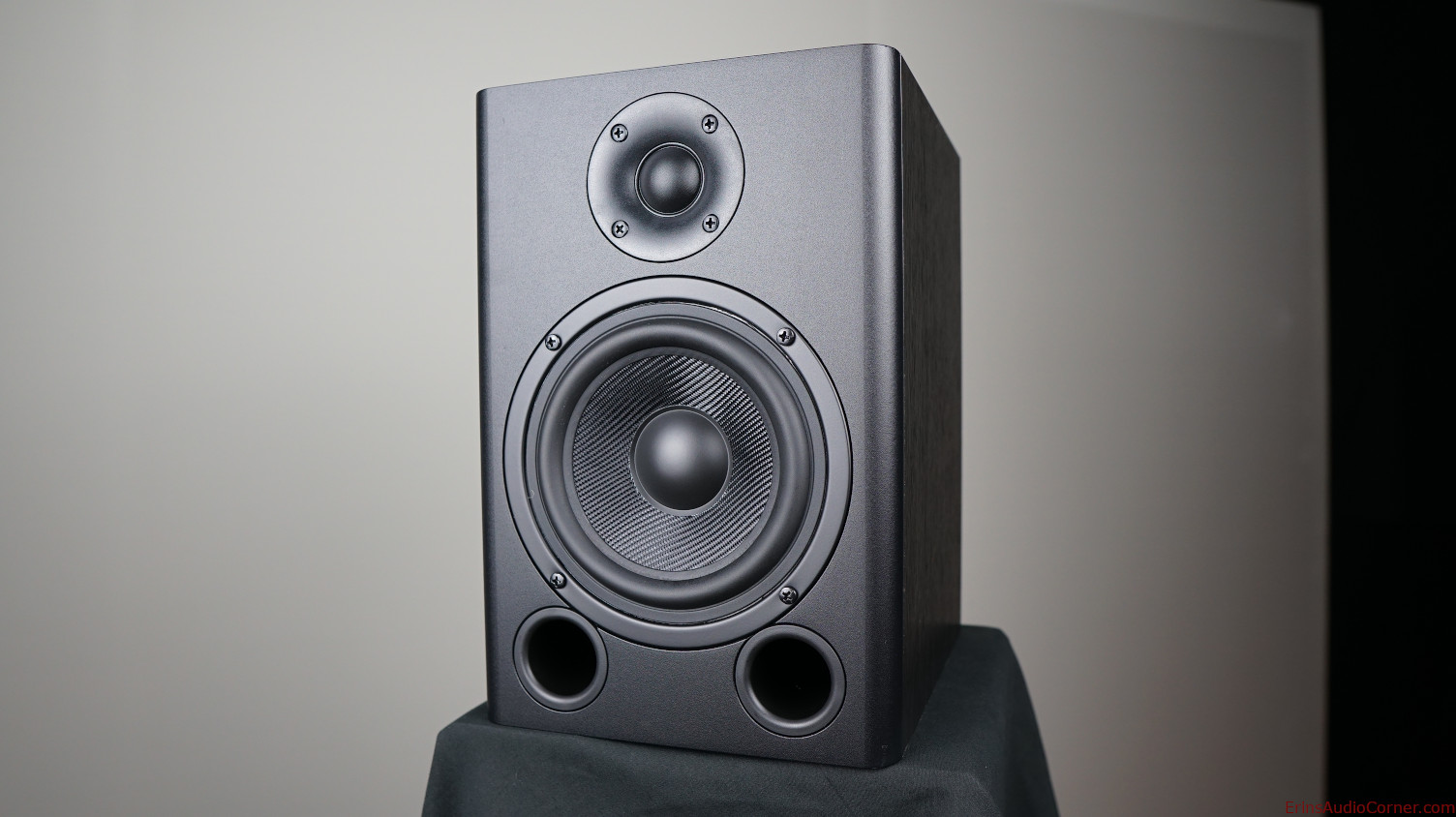
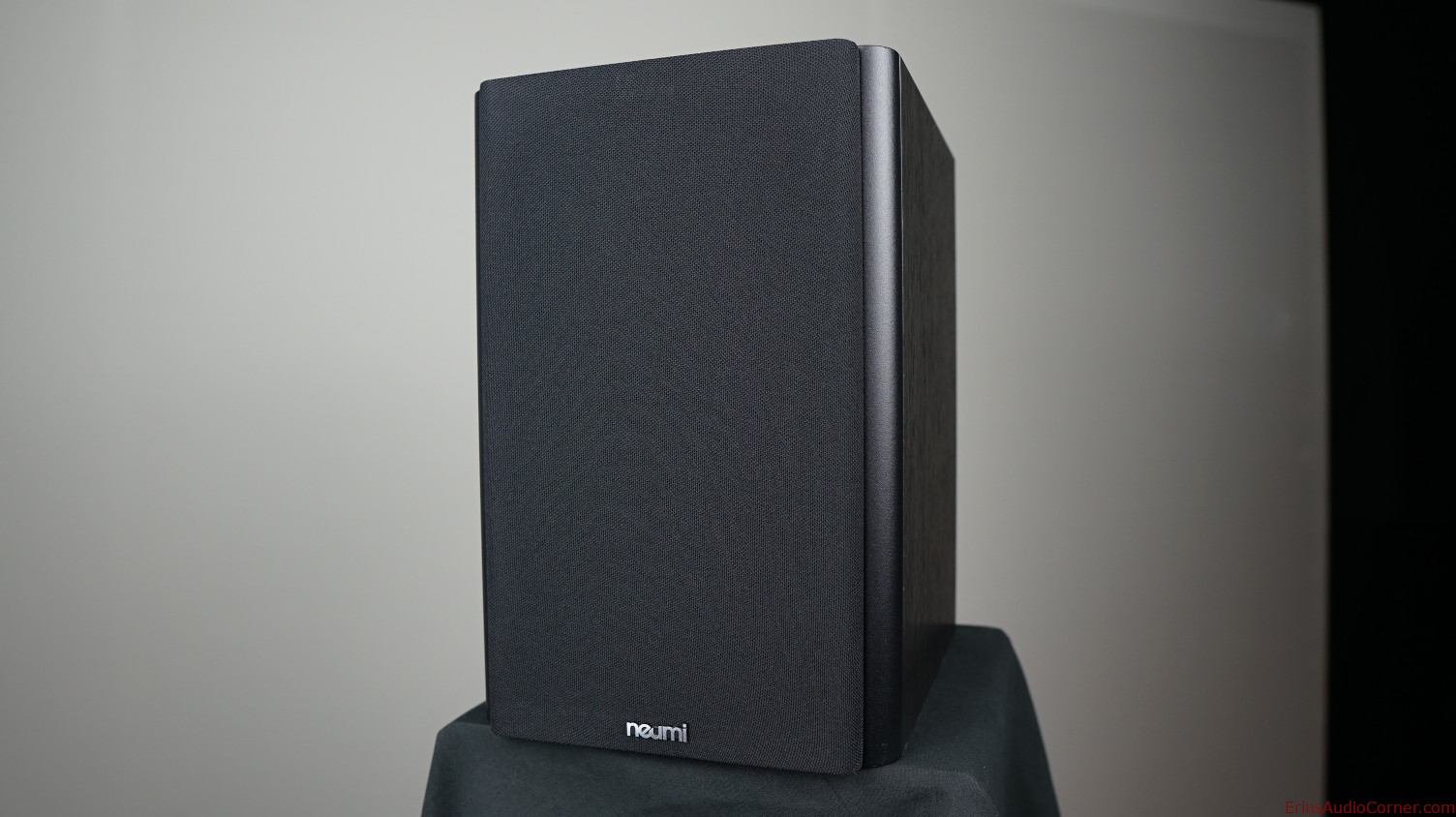
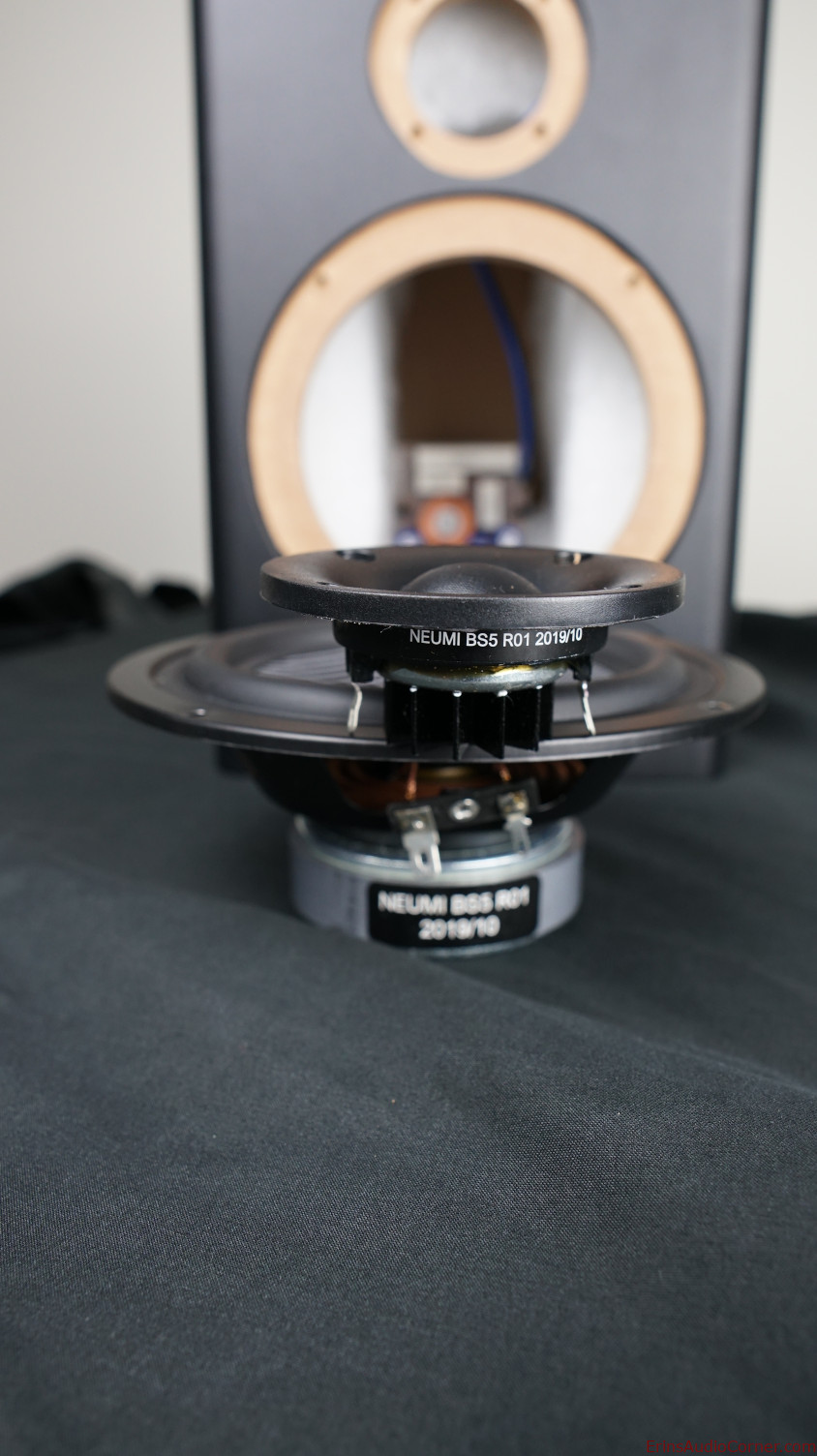
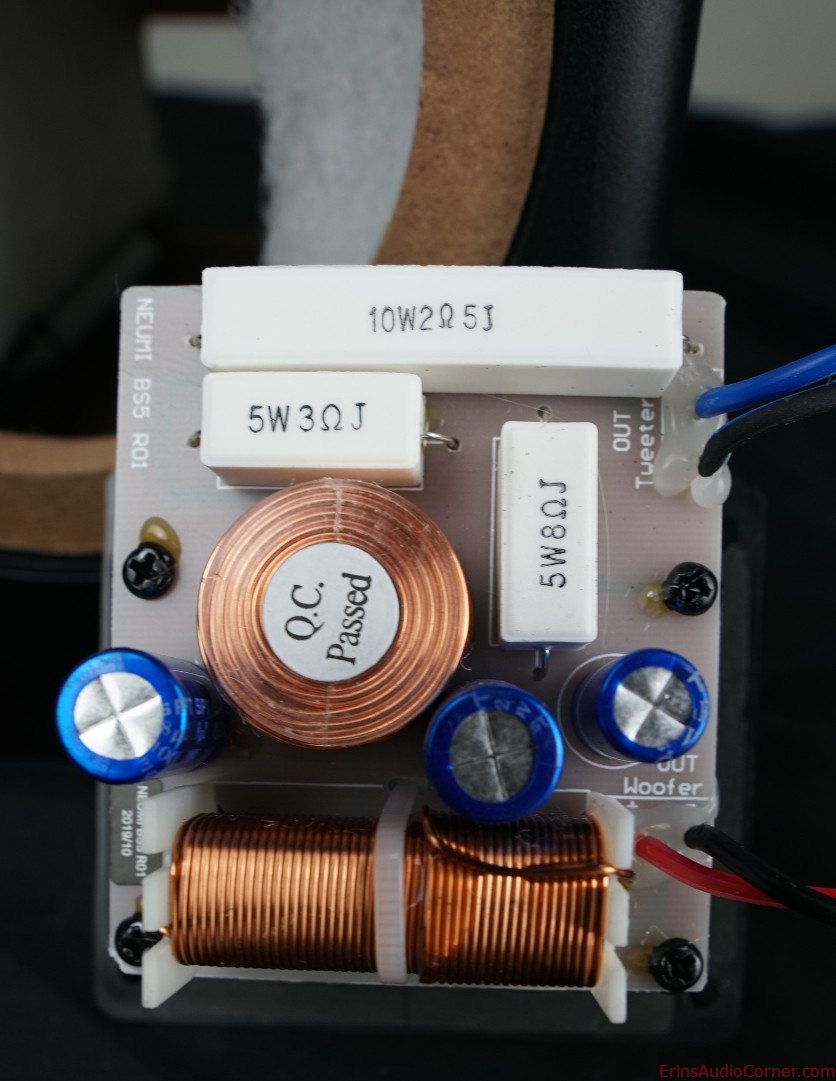
Impedance Phase and Magnitude:
Impedance measurements are provided both at 0.10 volts RMS and 2.83 volts RMS. The low-level voltage version is standard because it ensures the speaker/driver is in linear operating range. The higher voltage is to see what happens when the output voltage is increased to the 2.83vRMS speaker sensitivity test.
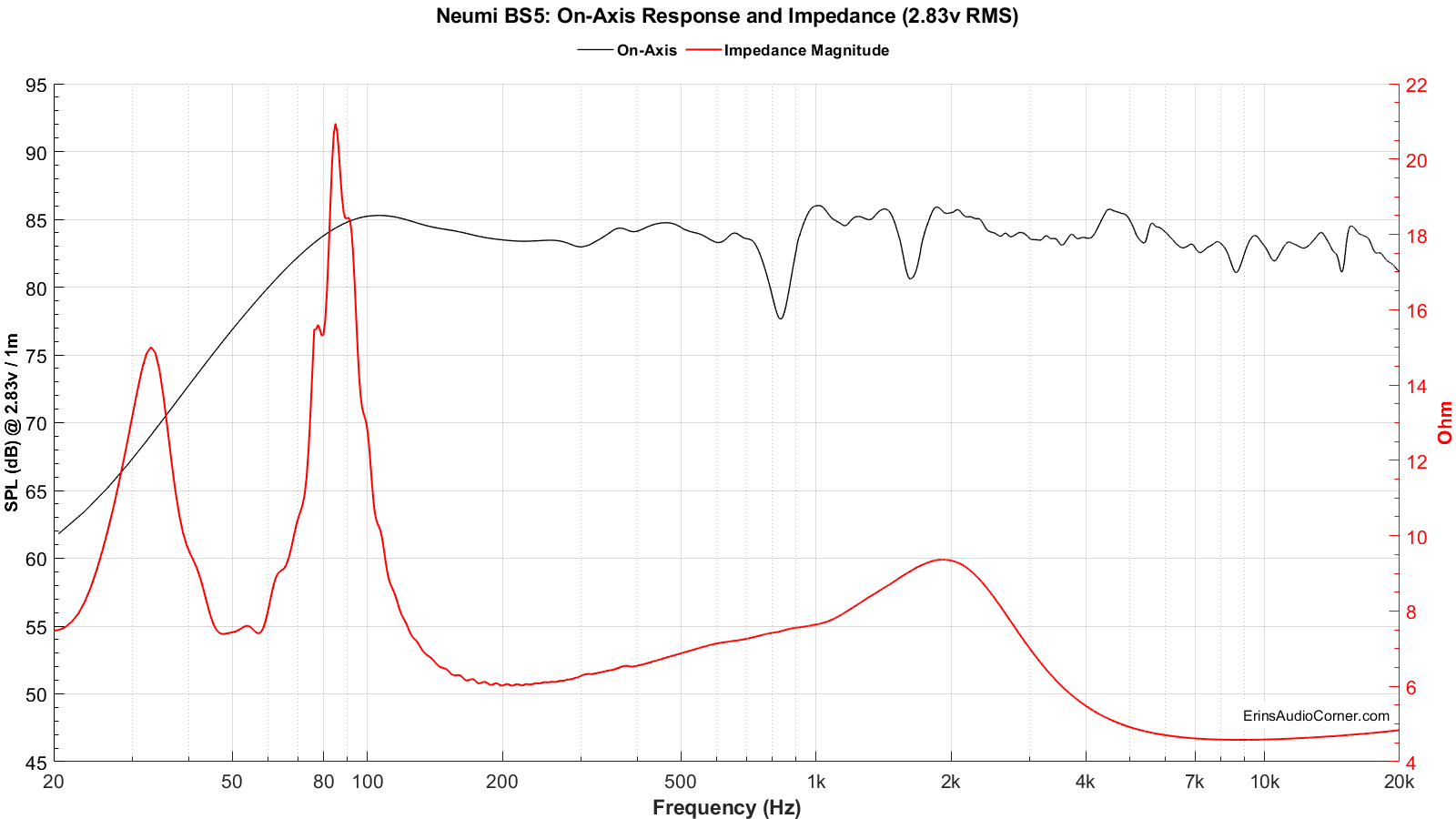
Frequency Response:
The measurement below provides the frequency response at the reference measurement axis - also known as the 0-degree axis or “on axis” plane - in this measurement condition was situated in-between with the woofer and the tweeter per the product manual. While the manual does do a good job of directing the user how to set up the speakers, I emailed Neumi to ask about listening angle and the grille use. I wanted to make sure I used the speakers the way they were designed to be used. Below is our email exchange:
So, per Neumi’s direction I listened to the speakers both on-axis (0°) and off-axis (≤30°) horizontally. I found the best angle to be directly on-axis. Otherwise, the treble was too subdued. When it came time to measure the speaker, I verified that 0° gave the most linear response and conducted the rest of my analysis with the reference axis being at 0° horizontally and between the mid/tweeter vertically.
Also, per Neumi’s direction, the grille was off for these measurements. I do have comparison data of the grille on vs off in my Miscellaneous section below.
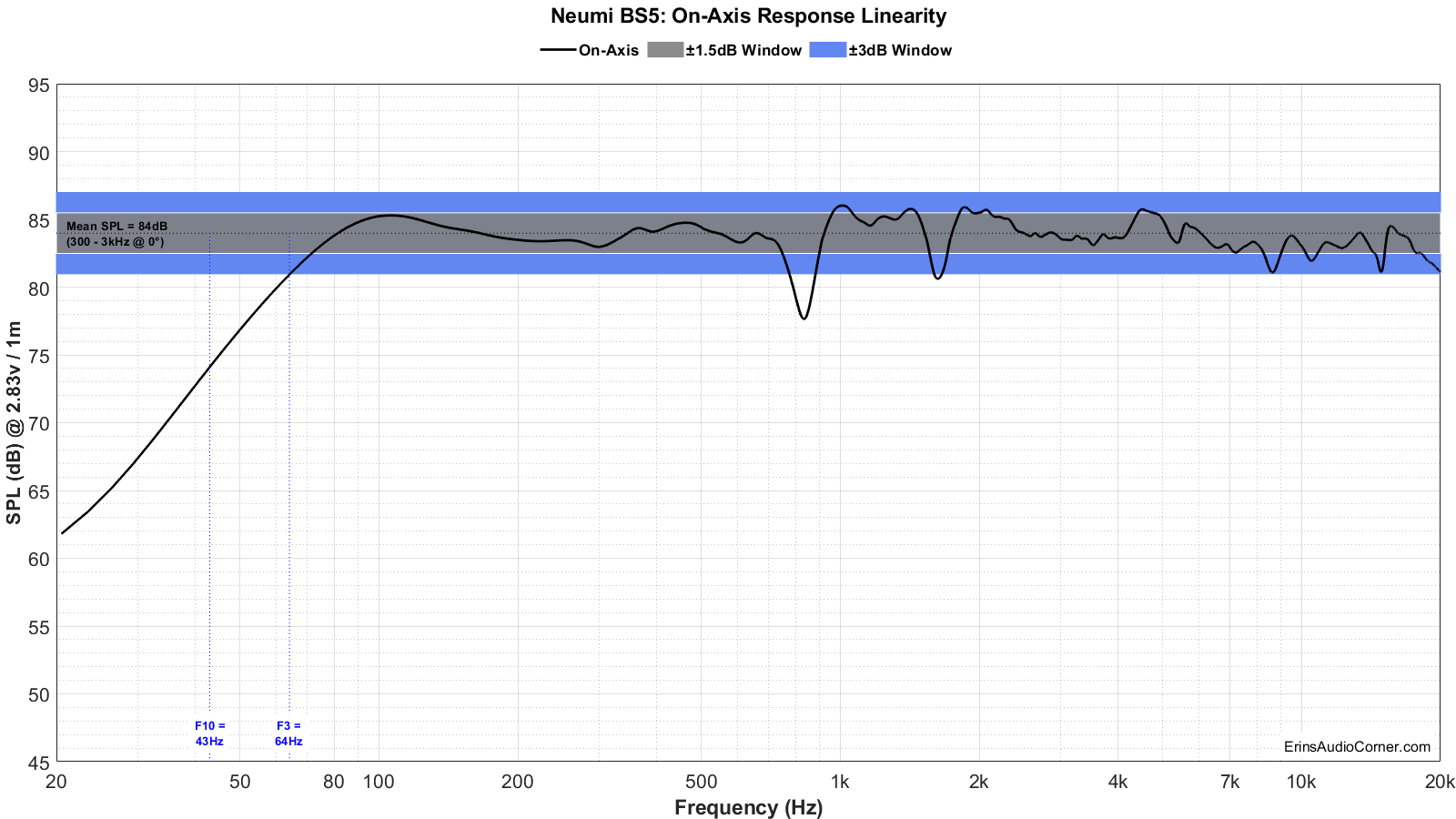
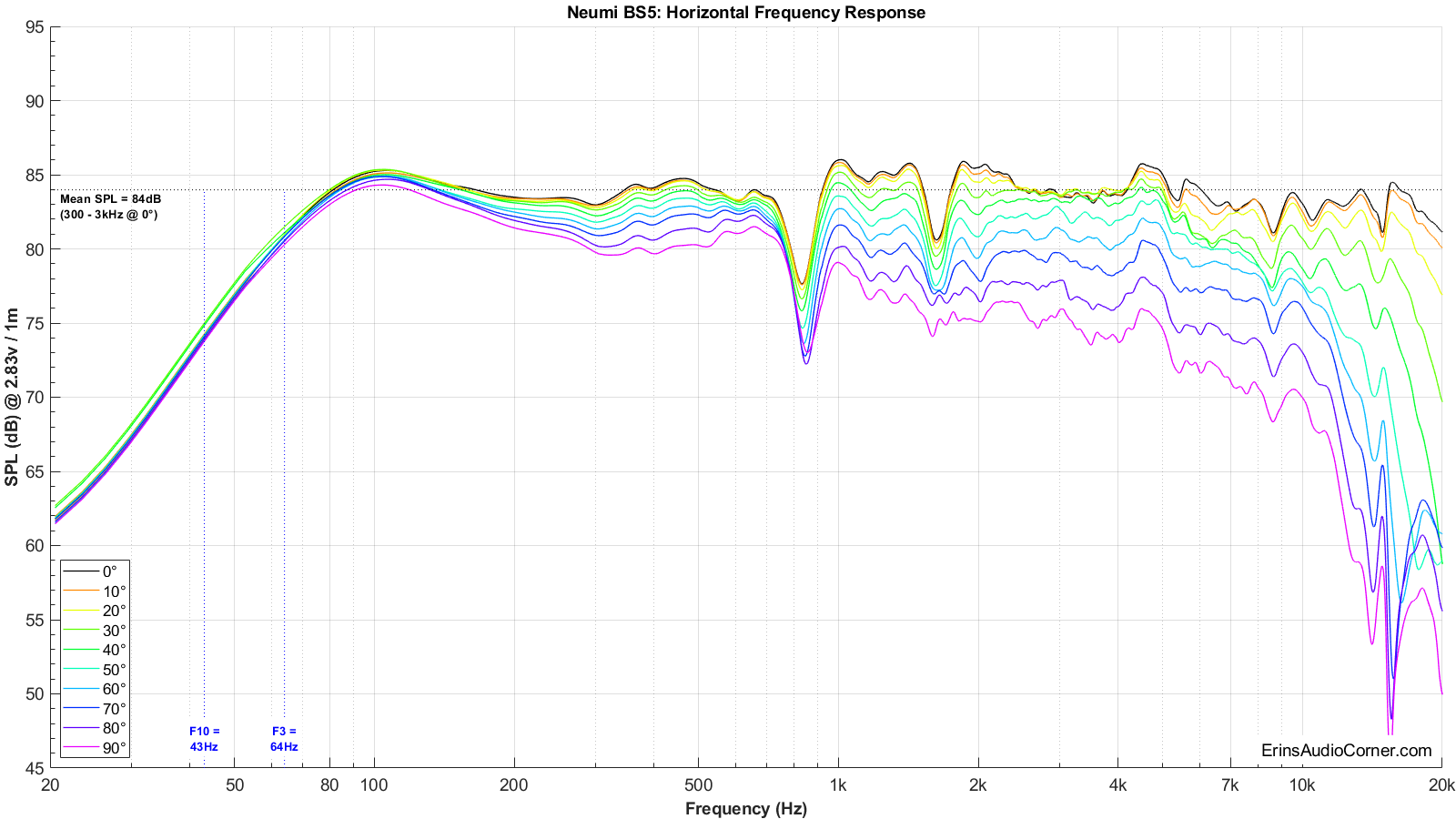
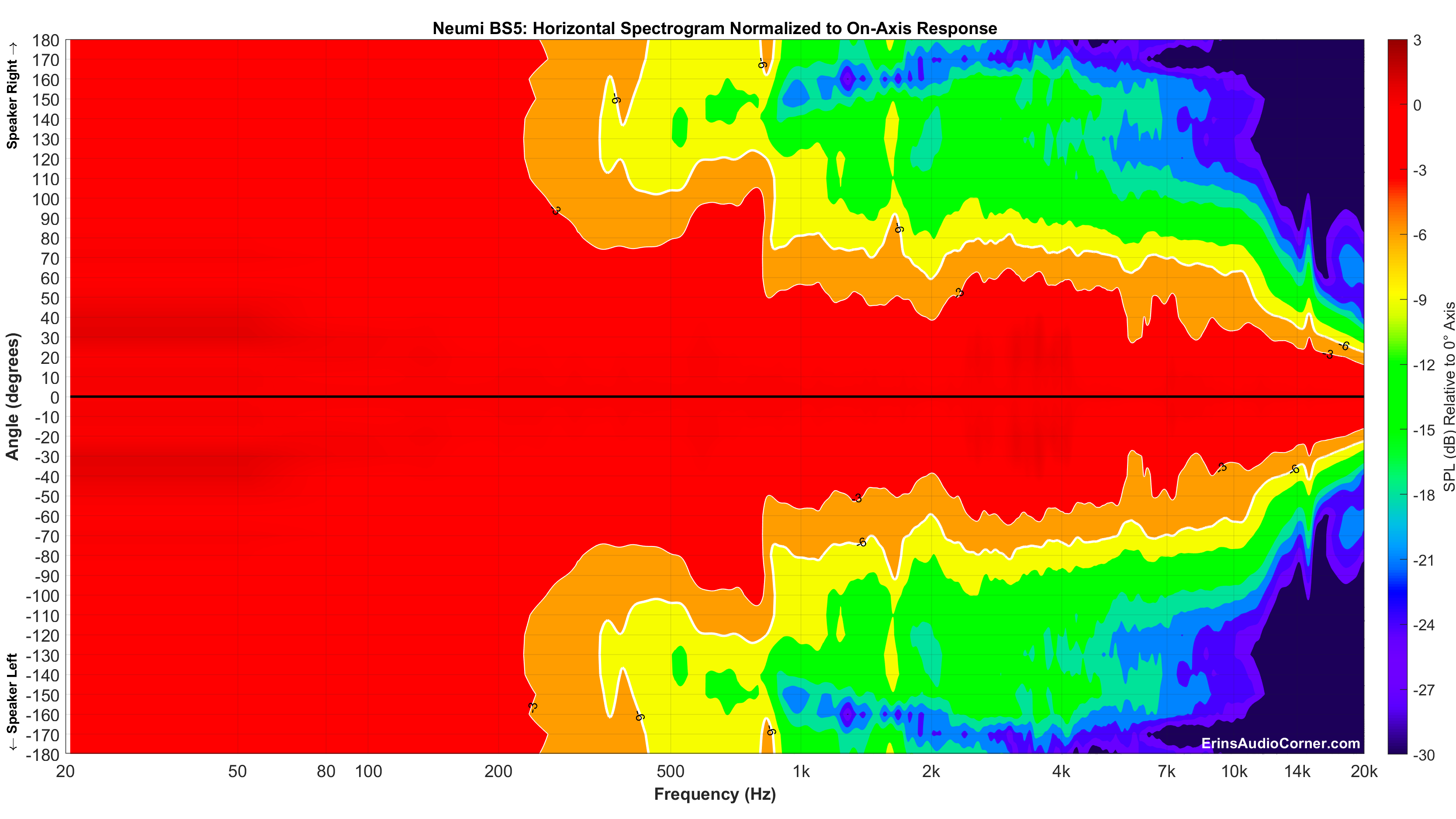
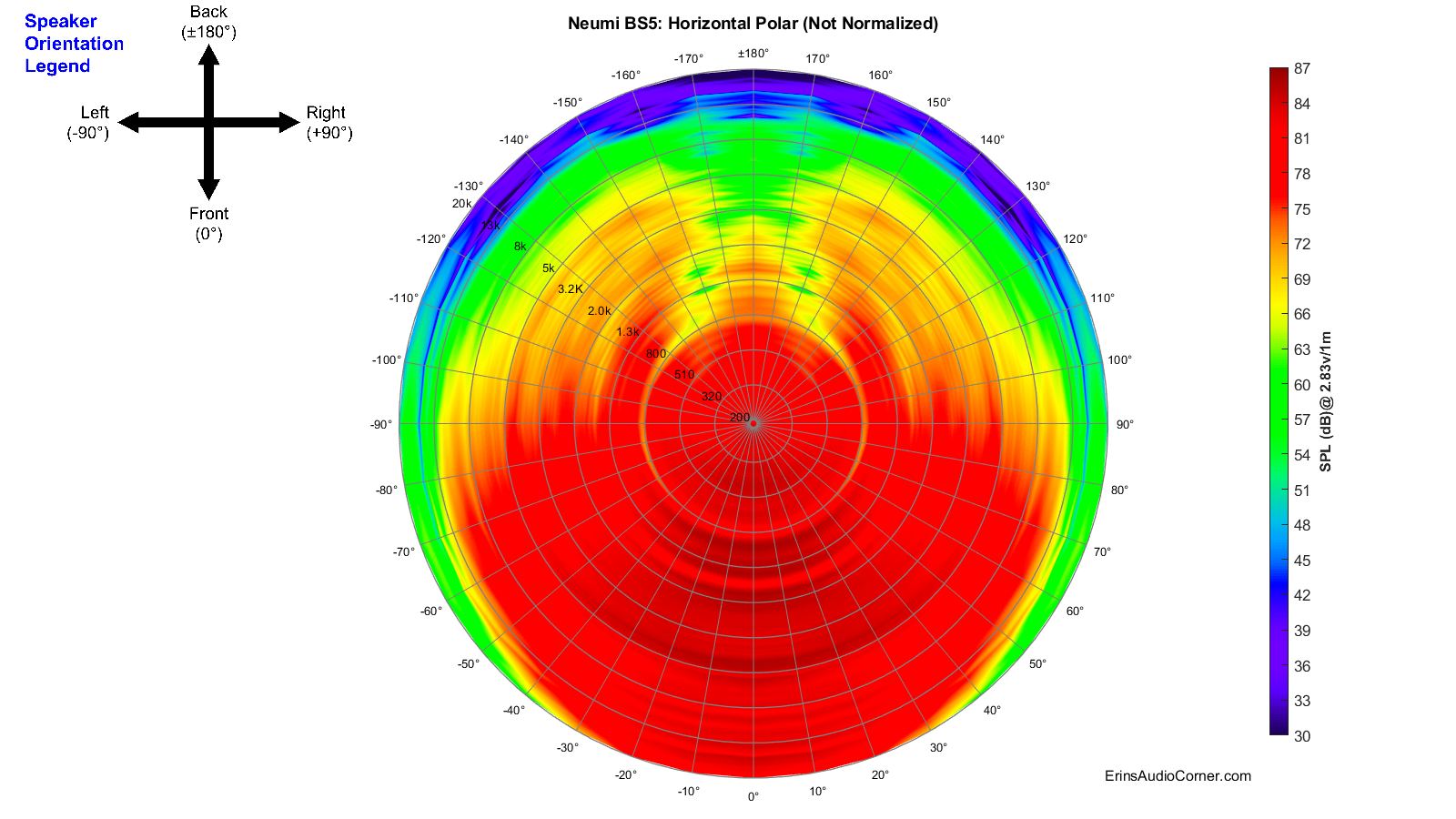
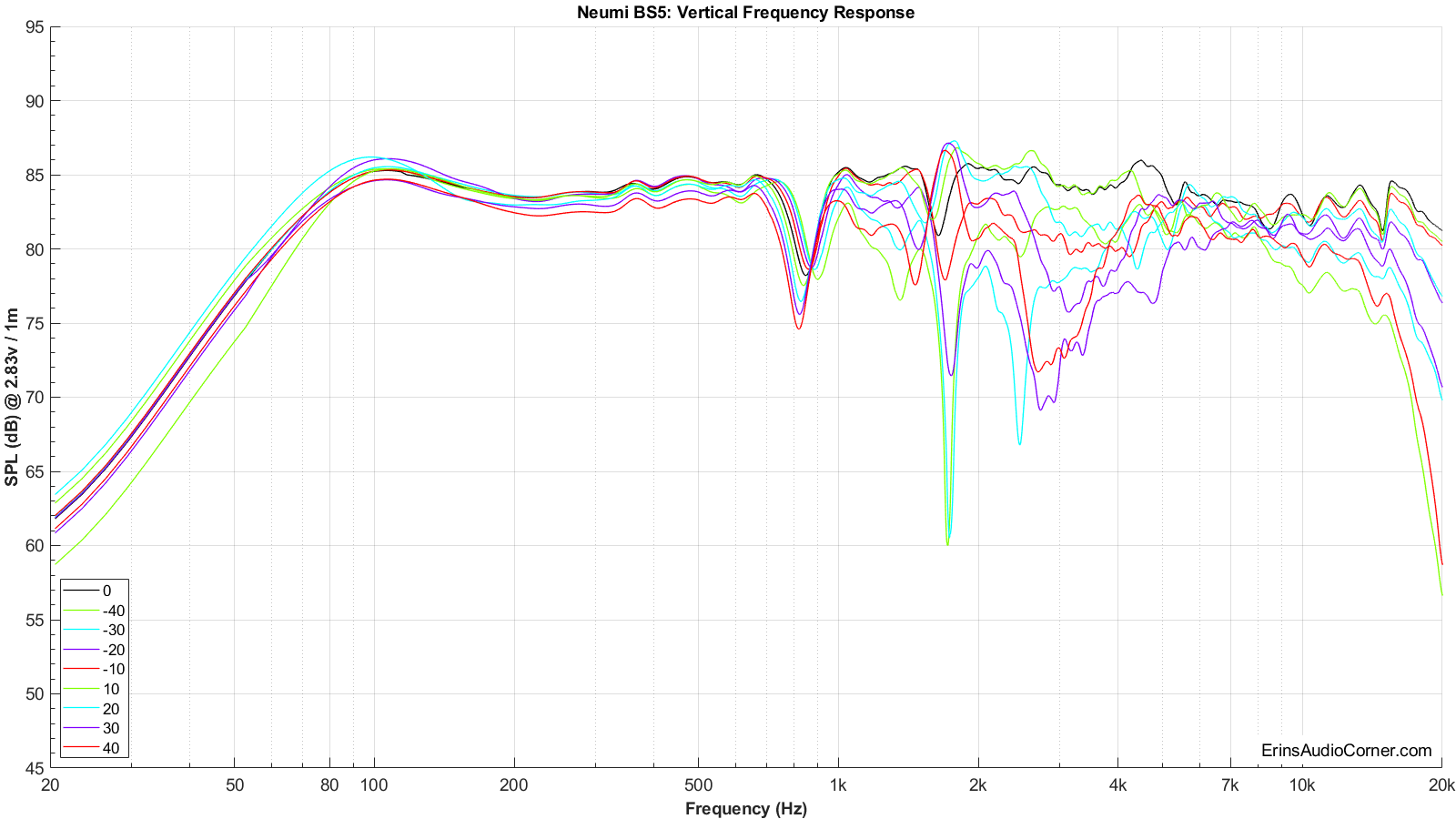
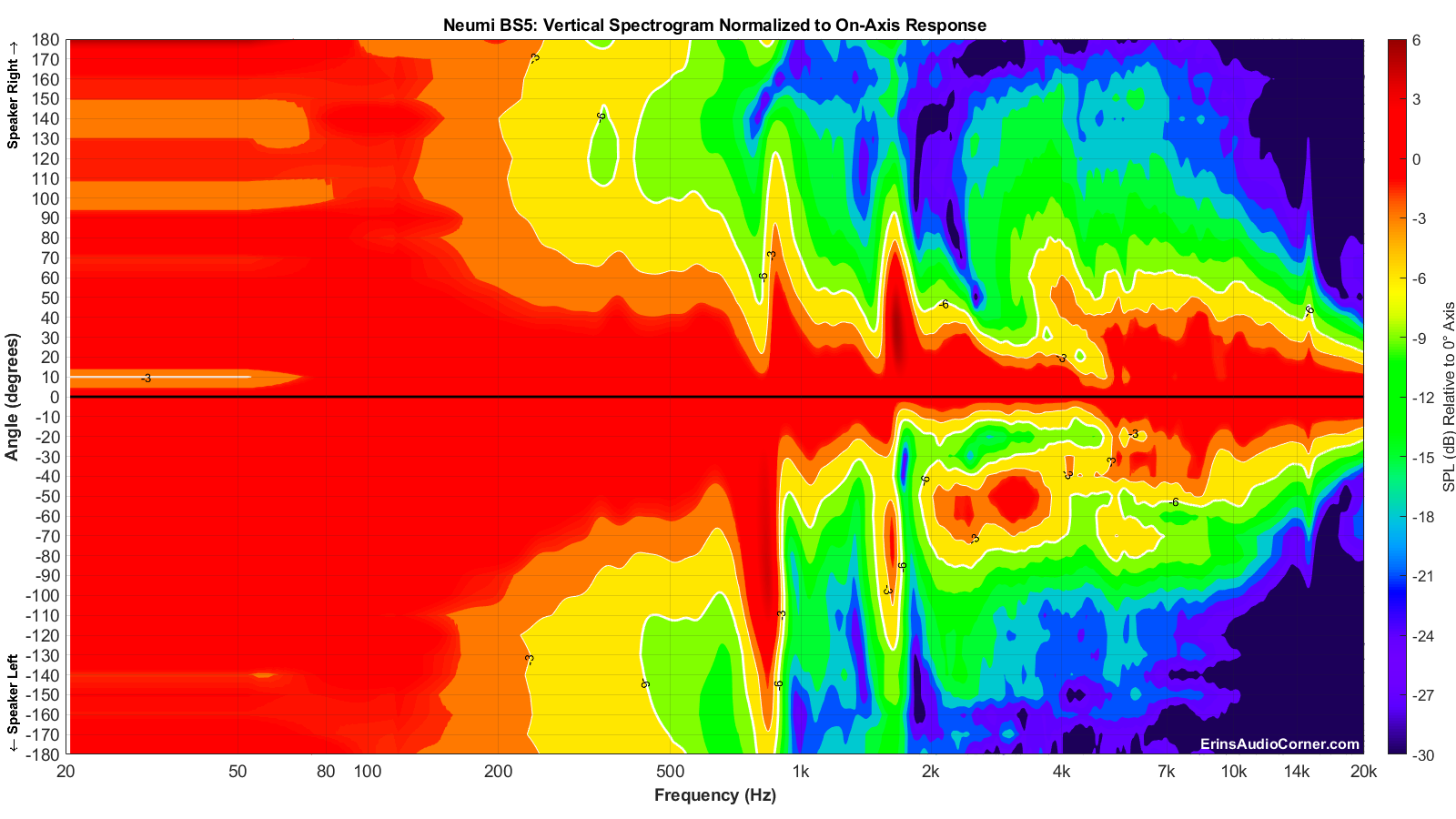
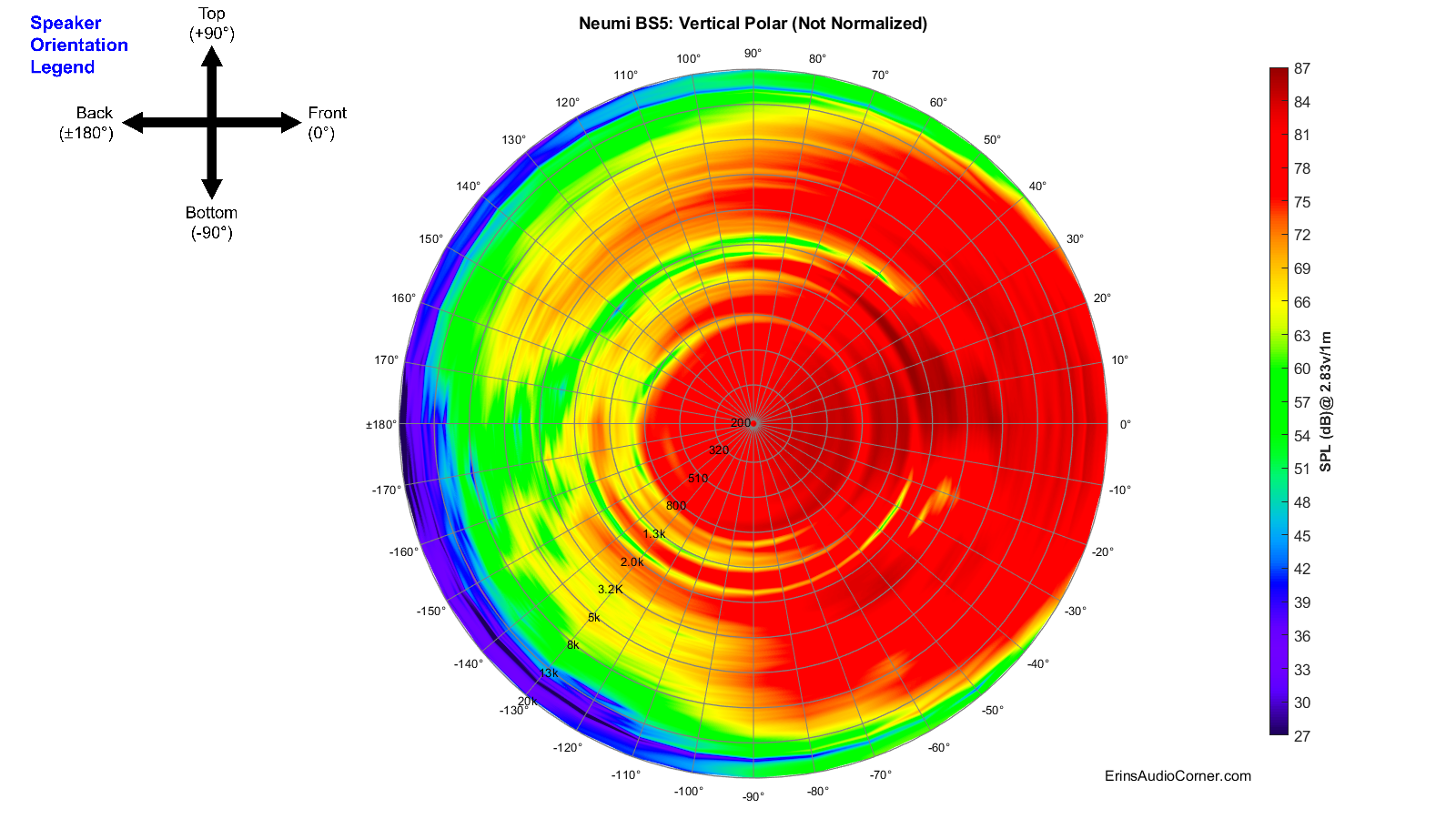
CEA-2034 (aka: Spinorama):
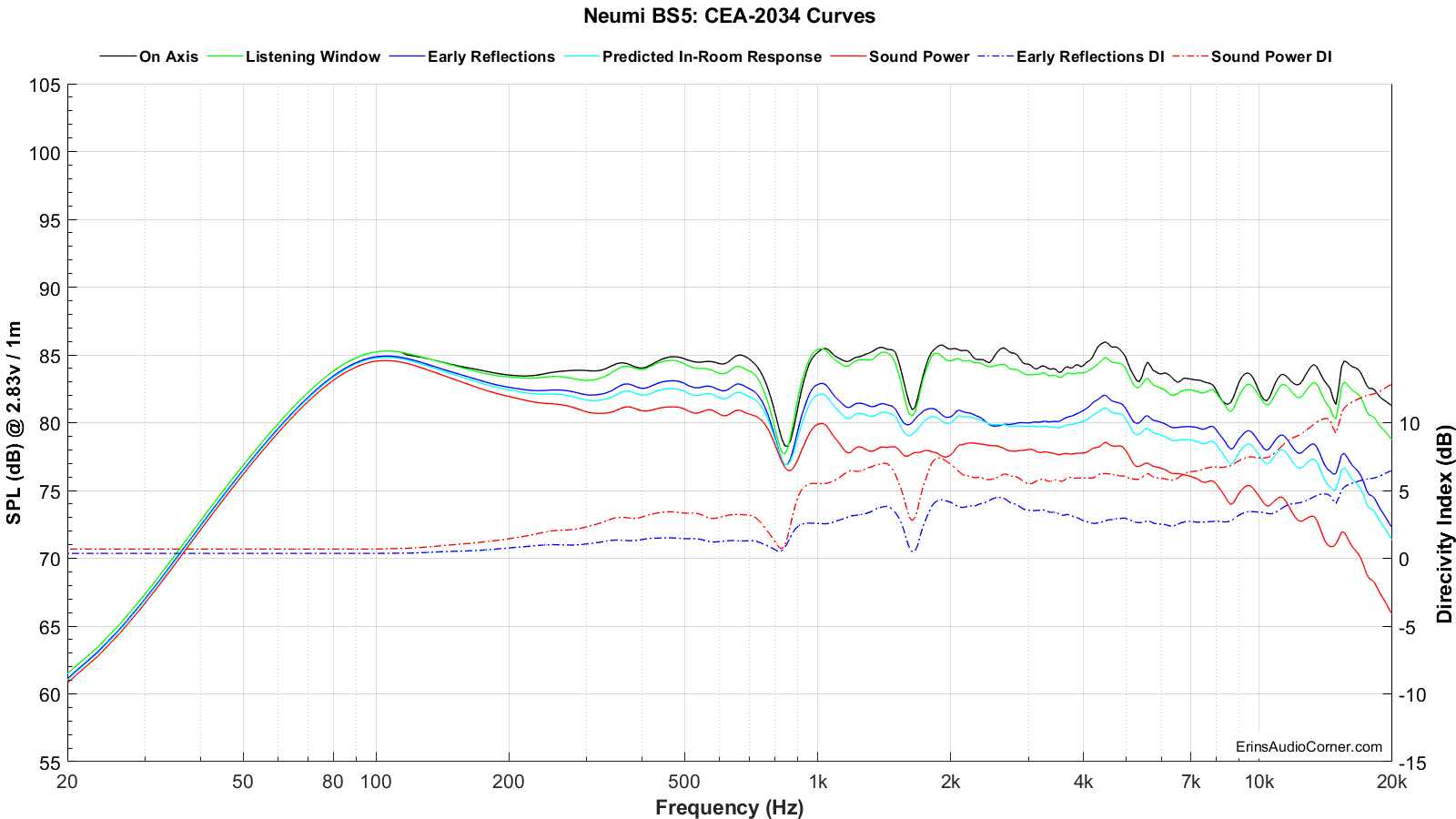
What we can learn from this data is that this speaker has significant directivity problems thanks to the deep nulls at ~800Hz and ~1600Hz. You can see it in the above spectrogram and globe plots as well as in all the measurements in the above graphic. The crossover is stated as 2.1kHz by Neumi and the nearfield data backs this up. Therefore, in this region you can see the directivity mismatch. Looking at 1kHz you see a rising DI until approximately 2.5kHz where the Early Reflections DI dips back down again. This is a sign the transition from mid to tweeter is occurring as the woofer is beginning to beam (radiate more forward than omnidirectional) and the tweeter is taking over, omnidirectional until approximately 6.5kHz (calculated based on dome size of 1 inch). The DI flattens out a bit through here but as the tweeter begins to radiate more directionally the DI increases again above ~7kHz. The tweeter rolls off sharply above 16kHz, causing directivity to increase further. What does this all mean to you? Well, mismatches in what is coming directly at you, on-axis, vs what is reflected around you can cause issues in stage and tonality cues.
Below is a breakout of the typical room’s Early Reflections contributors (floor bounce, ceiling, rear wall, front wall and side wall reflections). From this you can determine how much absorption you need and where to place it to help remedy strong dips from the reflection(s). Notice the strong dips again at 800Hz and 1600Hz.
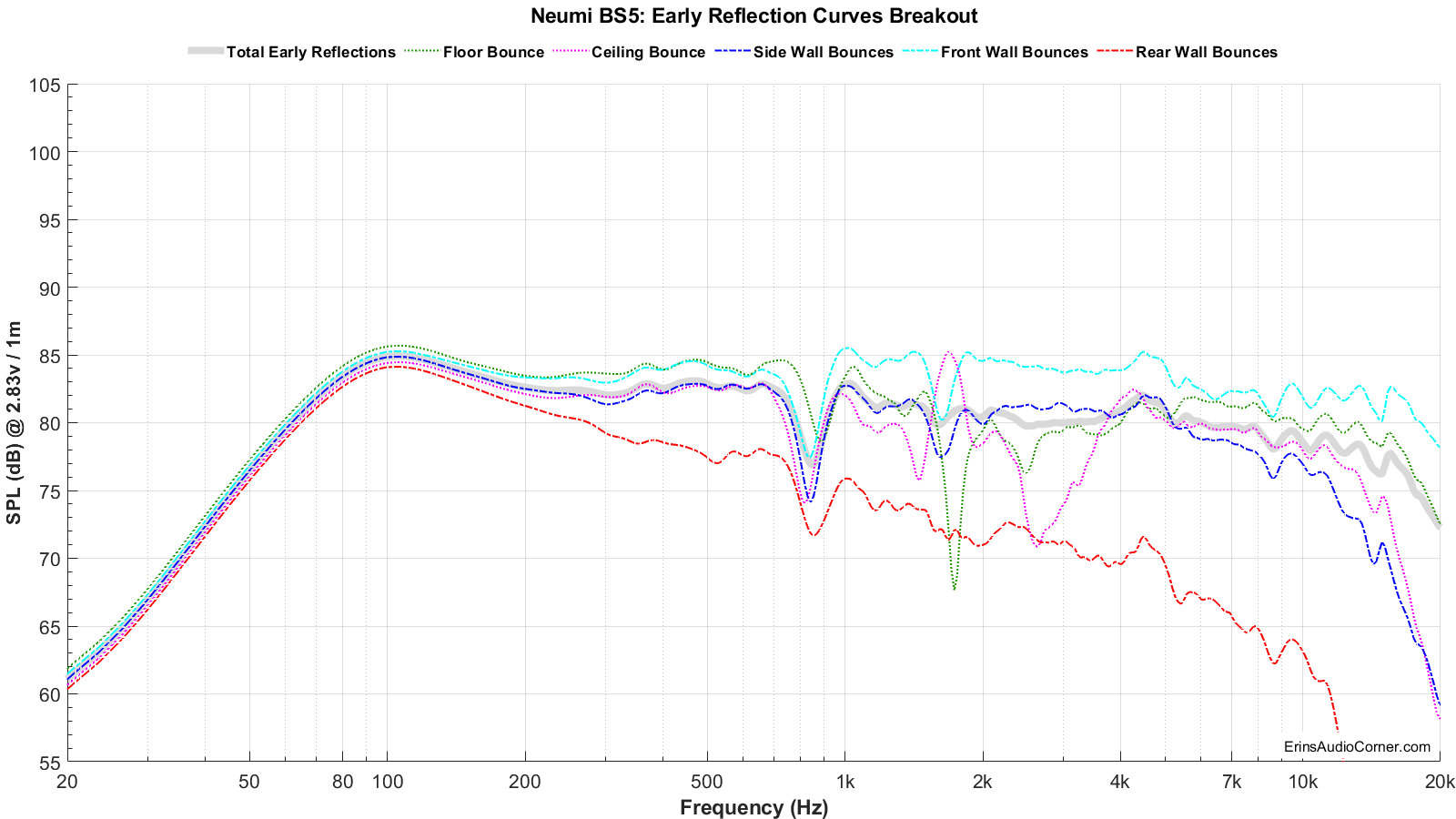
Total Harmonic Distortion (THD) and Compression:
Using the 93dB measurement tells you the measured low-frequency distortion at about 80Hz is near 3% THD and 6% at 40Hz. Will you hear that? Pure distortion is more subjective and depends not just on the listener but also no the program material.
I typically use distortion to tell me where mechanical failures are because the distortion I hear is typically either a rattle, buzz, plop from a woofer extending too far, or something along those lines. The bass is usually the problem. But in this speaker the midrange exhibits distortion at higher output levels and was also audible in my listening (primarily with male vocals).
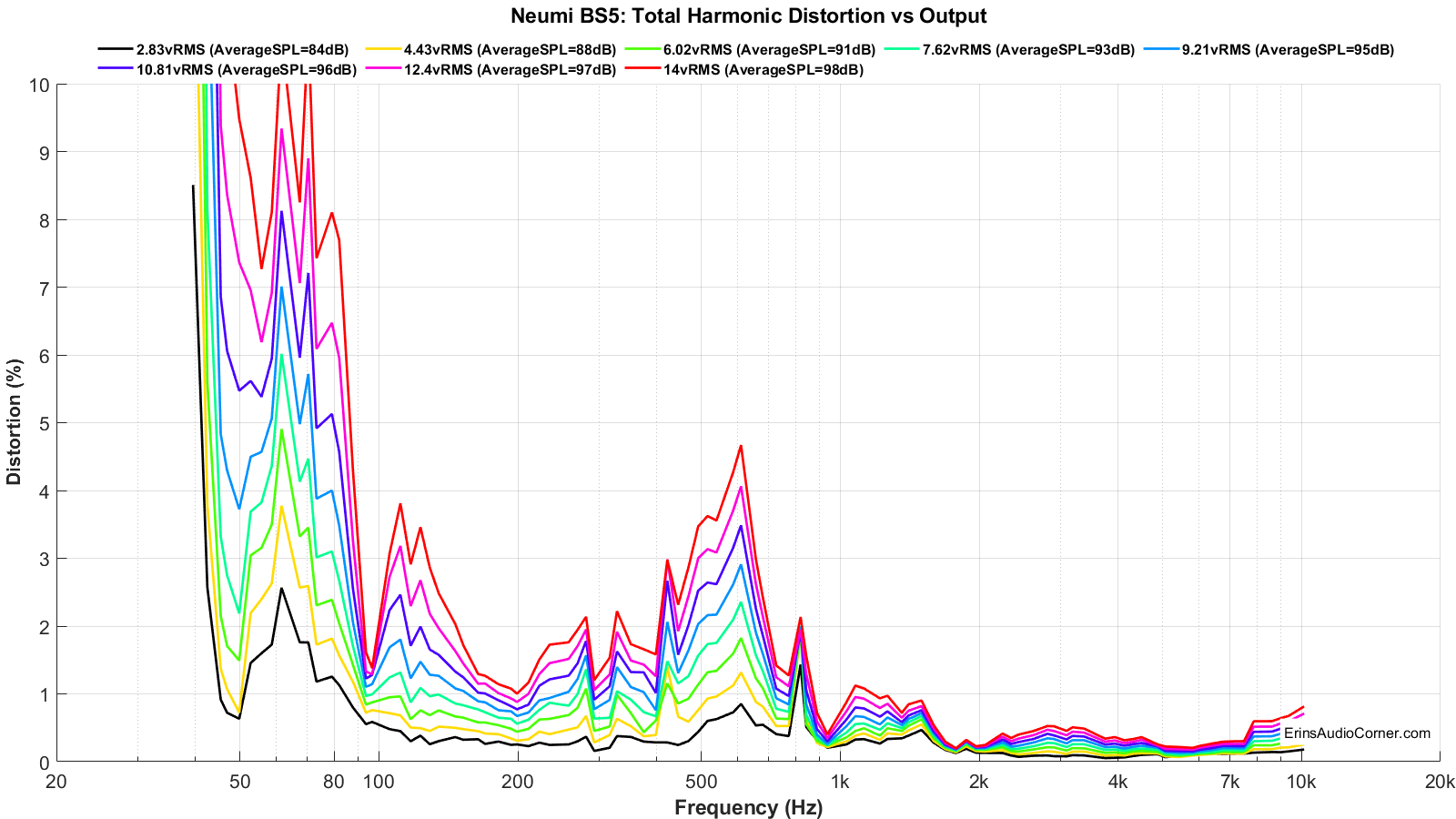
The compression effects shown in the image below are a visual way of seeing just what happens as the volume is increased. This one is straight-forward. Take the legend’s SPL value and add or subtract the data from the graphic. This tells you if you’re losing or gaining output (yes, you can gain output from compression; as un-intuitive as that seems). Mostly, the compression results in a loss due to temperature increase in the voice coil of the drive unit. Let’s look at a specific example. Take the 90dB at 4 meters target listening volume provided above. Again, you need 93dB’s (7.62vRMS) data. At that volume, the highest amount of compression measured is about 1dB at 40Hz and about 0.25dB at 50Hz, decreasing until about 200Hz. At some points the speaker suffered >2dB compression at 40Hz with 14vRMS. Overall, the compression results tell you what common sense would tell you: don’t try to use this speaker in place of a subwoofer at anything other than lower volumes. Otherwise, at louder listening volumes you lose over 1dB of output. And it is audibly present as a very grainy and “limited” sound; there are no dynamics at this output and that’s exactly what I heard in my listening tests when I pushed the speaker to uncomfortable levels.
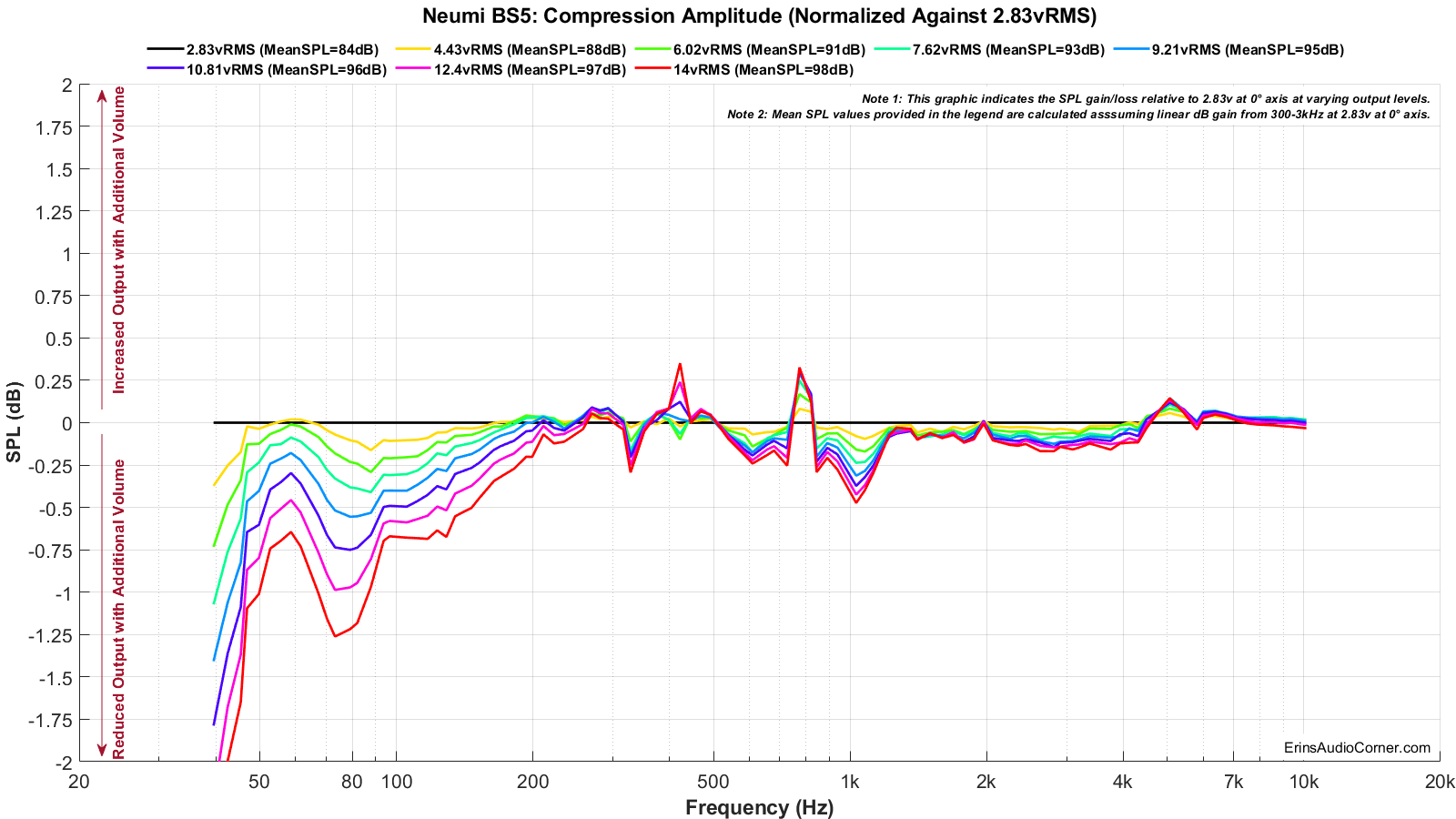
Extra Measurements:
These are just some extra sets of measurements I completed. Some, I didn’t process through my MATLAB scripts so they’re kind of raw. But I know some would like to see them so here you go.
Grille on vs Grille off at 0° and 45°.
The grille on case results in an increase in comb filtering (higher amplitude peaks/dips). Leave the grille off.
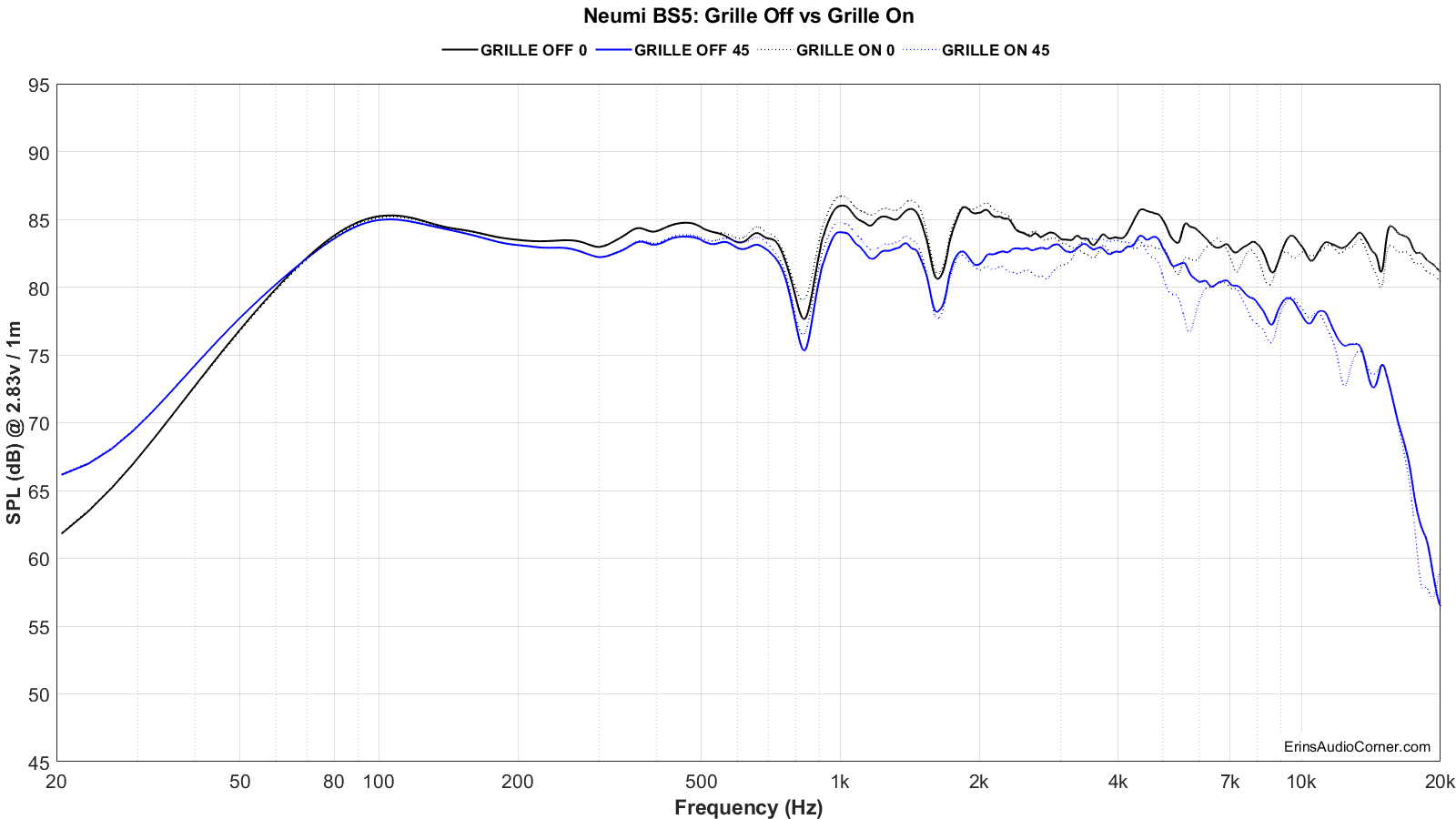
Accelerometer Cabinet Resonance Test.
I used an accelerometer. I attached the accelerometer to the side (top, middle, bottom), back and front of the cabinet and fed a 2.83vRMS signal through the speaker.
I have overlaid all these results against the on-axis response as well. Note, however, the accelerometer is NOT calibrated for level and therefore is only intended to show relative changes. What you look for in this data is large peaks that would indicate a resonance. I’m seeing a lot of mountains and molehills, but I don’t think this data is conclusive enough to do anything other than make a mountain out of a molehill. Others may disagree.
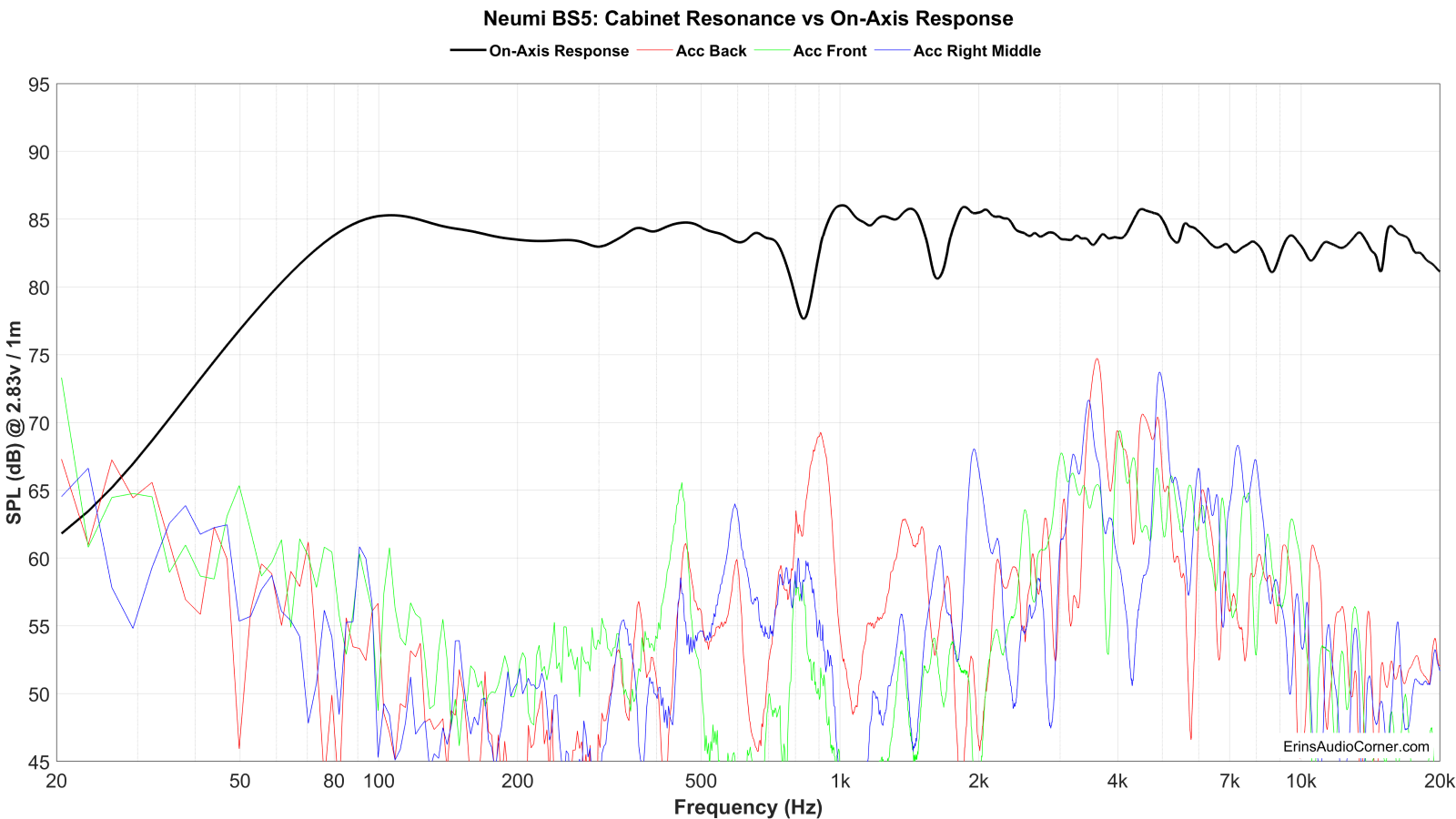
Since the accelerometer is not calibrated for voltage in the above graphic, I chose instead to view the results via a Sonograph, shown below. This shows a long decay for 800Hz - 900Hz. This seems to line up with a resonance of the ports, shown in the next section.
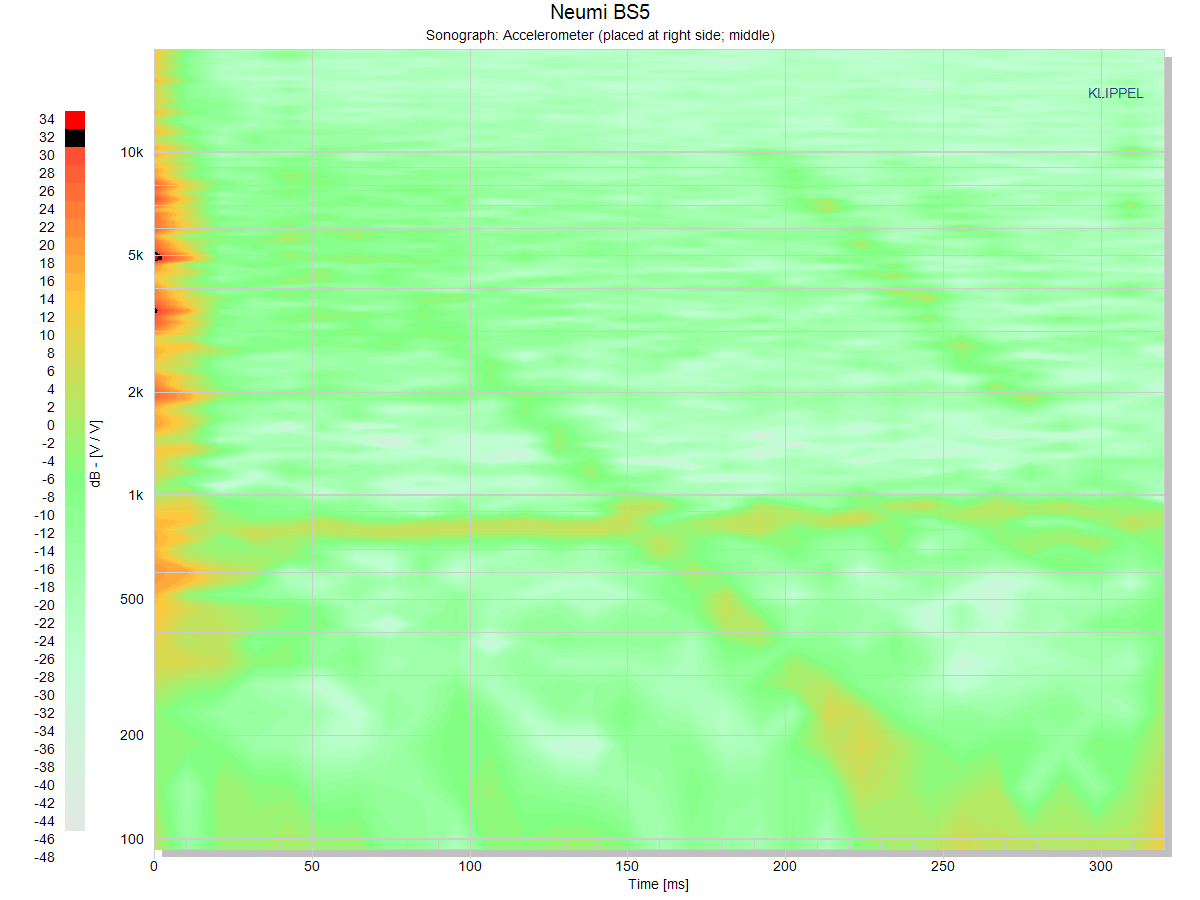
Nearfield measurements.
Mic placed about 0.50 inches from each drive unit and port. While I tried to make these as accurate in SPL as I could, I cannot guarantee the relative levels are absolutely correct so I caution you to use this data as a guide but not representative of actual levels (measuring in the nearfield makes this hard as a couple millimeters’ difference between measurements can alter the SPL level). Got it? Good.
There are a few noteworthy things here:
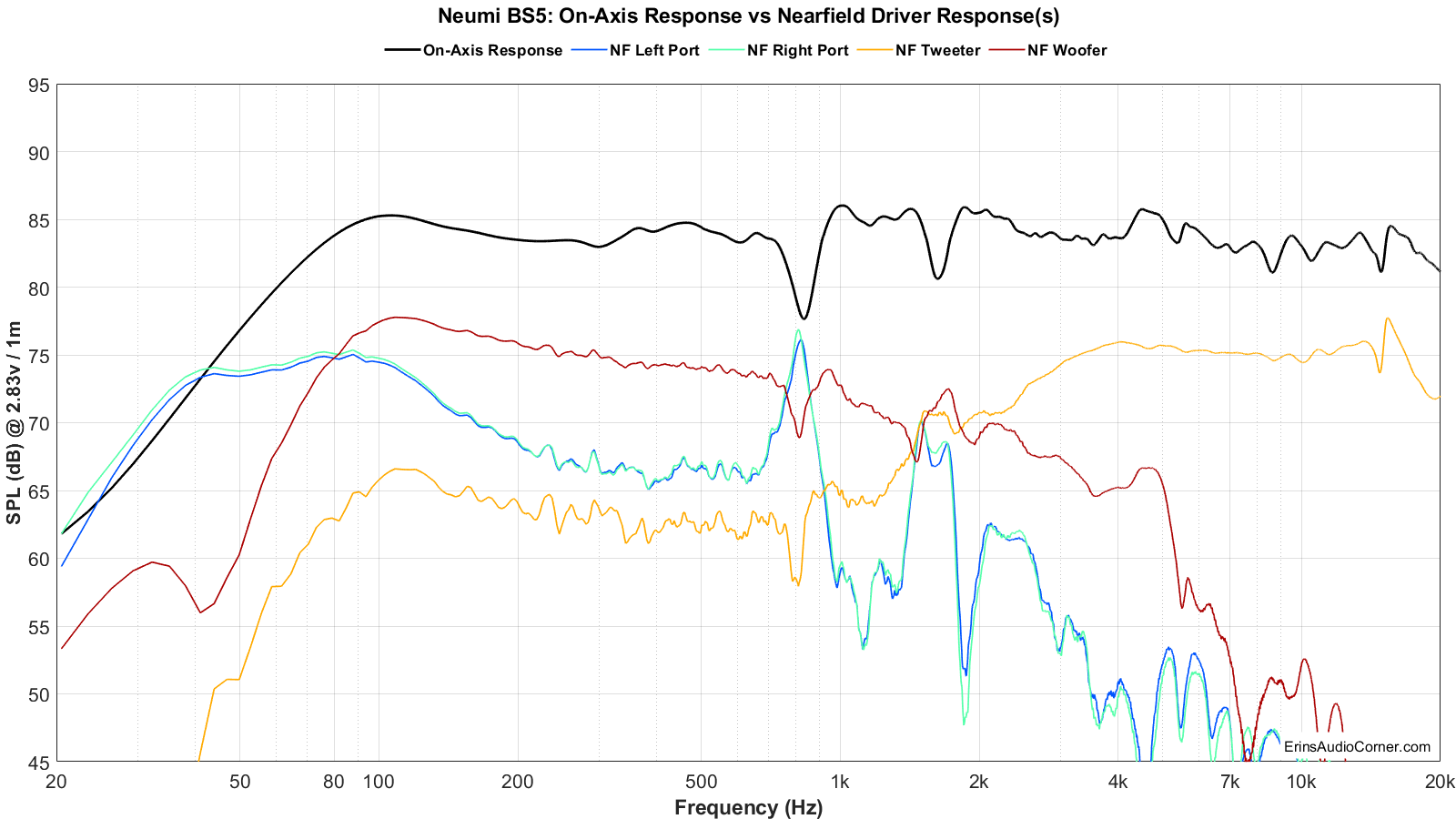
Step-Response.
One not zoomed and one zoomed.
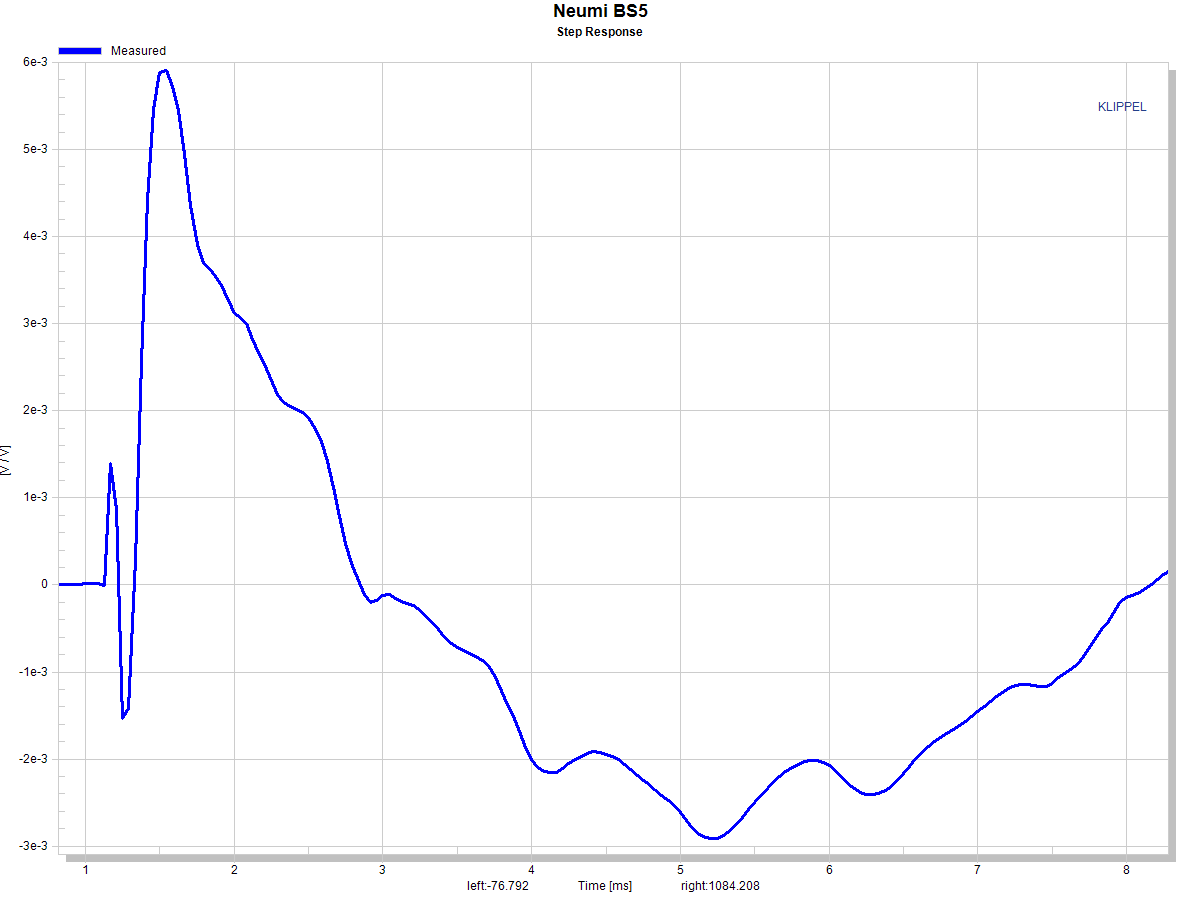
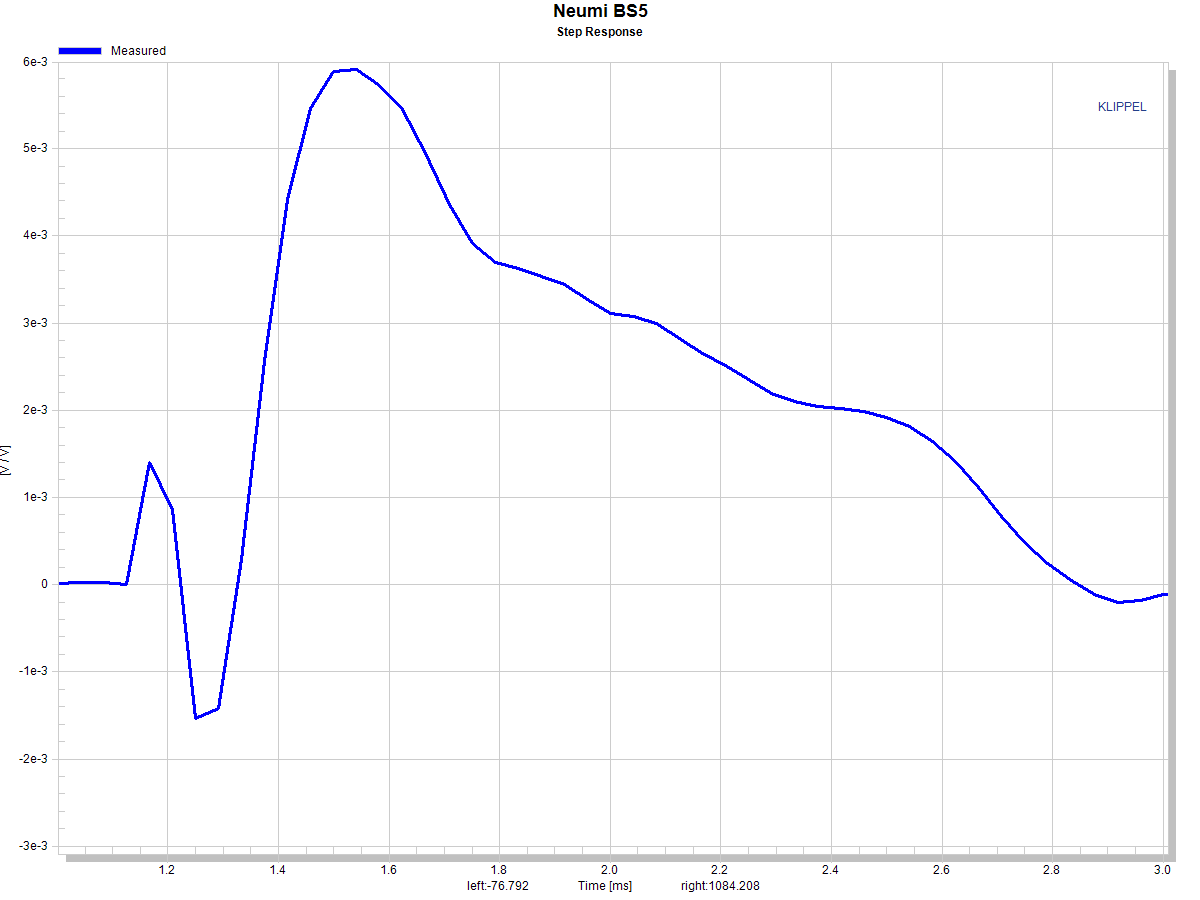
Plugging the port (making the speaker sealed).
To test whether the ports were, indeed, the culprit of the deep nulls I took my socks off and plugged the ports. Don’t worry, I had only been wearing the socks for 3 days. Sure enough, plugging the ports filled in the nulls. But it also decreased the low frequency output by about 2dB below 300Hz.
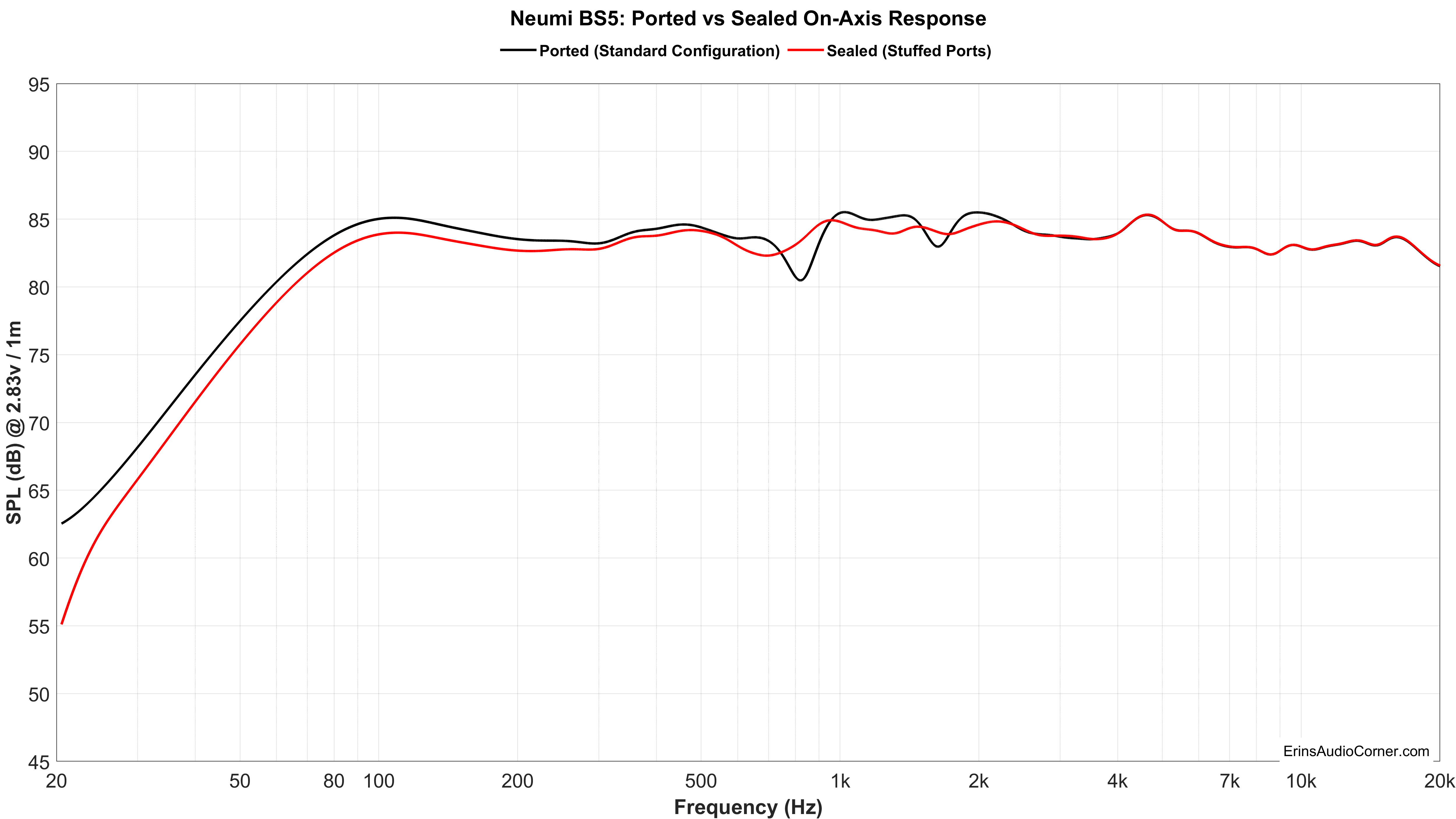
Objective Evaluation:
Much of what I am about to say I have already touched on under the data. But to recap:
Impedance:
Frequency Response/Spectrograms/Globes/Spinorama:
Distortion/Compression:
Subjective Evaluation:
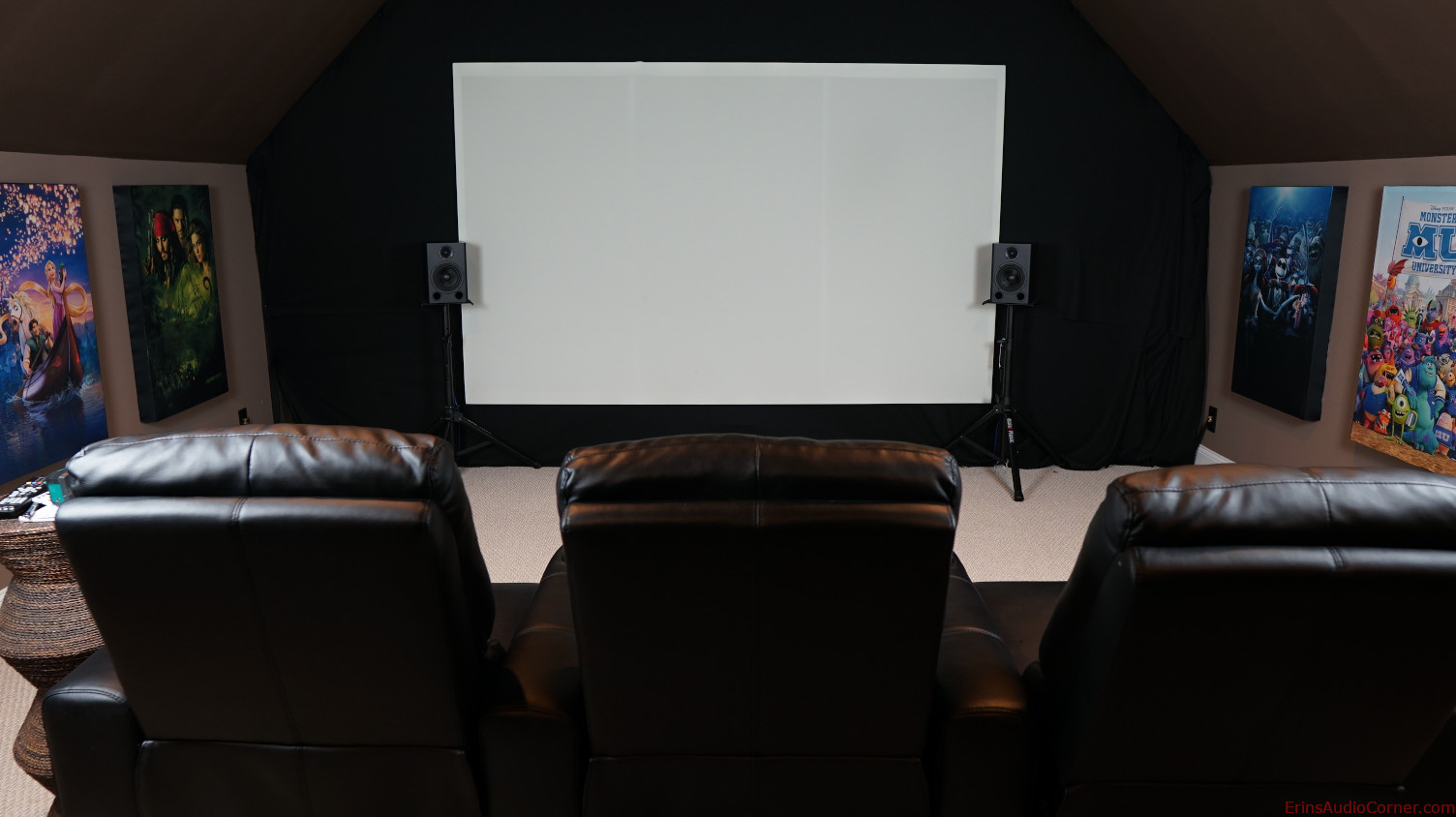
Subjective Analysis Setup:
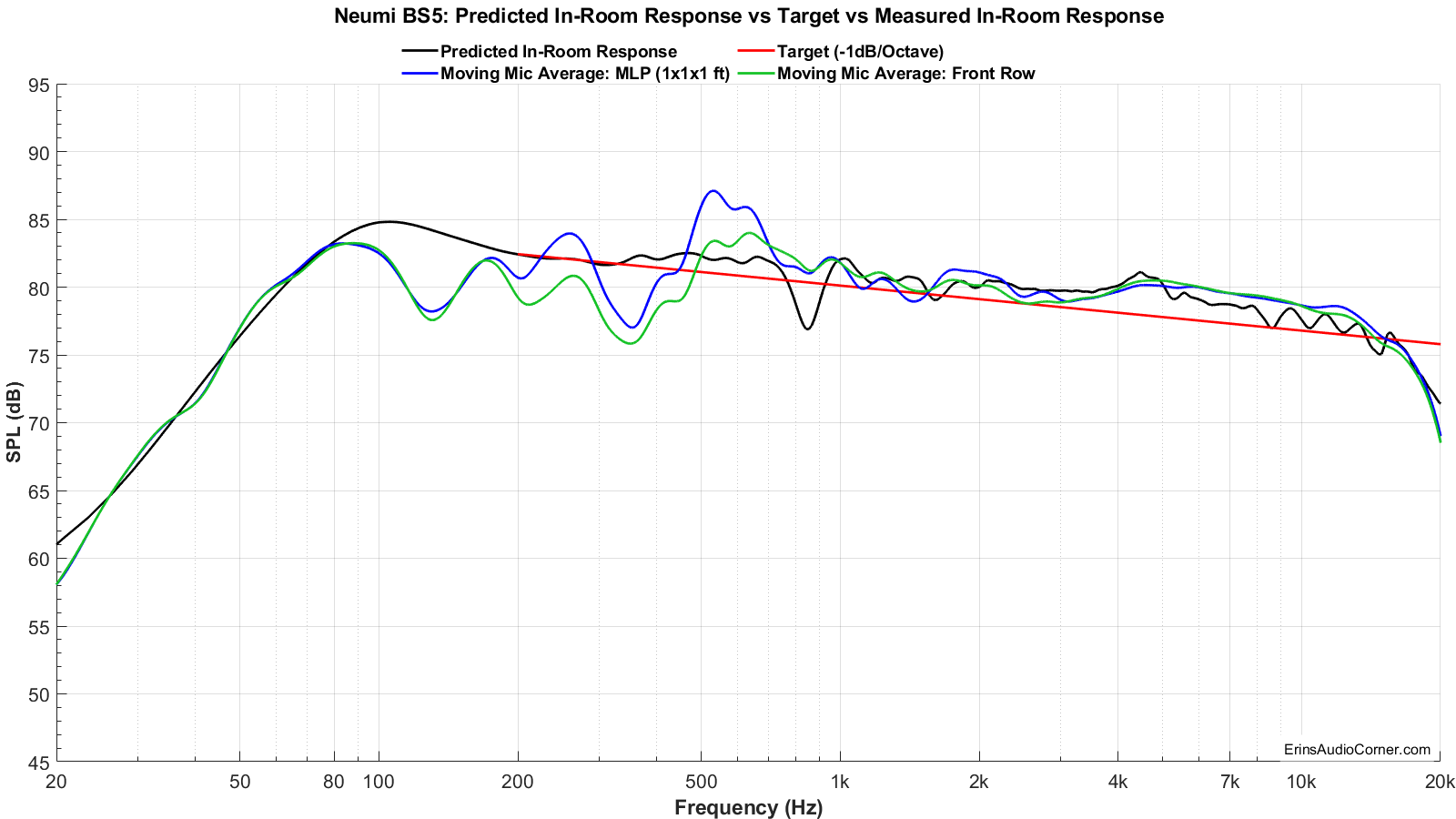
Here’s the rundown of my subjective notes (in quotes) and where it fits with objective:
I didn't have a chance to run Dirac Live so I can't speak to what the sound would be post room correction.
Bottom Line
This speaker doesn’t measure perfectly. And, for the most part, I was able to match areas of concern between my subjective listening session and my measurements. Though, I didn’t have any significant gripes about the sound. The one main dislike for me was the reduced treble compared to the midrange. The bass is pretty well blended to the midrange despite the moderate bump in response around 100Hz. There is not much output below this at higher levels, but I can forgive the shortcomings in the bass department because the BS5 isn’t trying to pretend that it can play like a subwoofer. I have seen other 5-inch woofers with higher linear excursion than what these woofers are seemingly capable of but just one of those drive-units alone costs more than this pair of speakers. The midrange distortion is an issue if you’re going to listen at high levels; for me being at 90dB at 11 feet (which is about 93dB at 8 feet per this awesome calculator). These aren’t reference level speakers. But I think anyone buying them understands the implicit output limitations. Under 90dB at 11 feet, the sound is more balanced and undistorted.
Personally, I think these speakers would be better suited as desktop/computer speakers sealed (stuff the ports) and against a wall. The wall would give you a +6dB increase on the lower end to help make up for the plugged ports but plugging the ports would get rid of the nasty resonances that plague this speaker. I would not place these in a corner in a small room, though. Doing so creates a combing effect you do not want. Alternatively, you can use these as small satellite speakers for a budget-minded home theater. However, if you want ultimate hi-fidelity at reference levels on a shoestring budget then these speakers are not it. The frequency response deviations and distortion keep it from that goal. But, when used within reasonable limits, this is a “fun” little speaker that is enjoyable and a great entry into the hi-fi realm at $90/pair. I hate using the “but it’s cheap” argument but, really, this is a $90 pair of bookshelf speakers. More than that, though, there’s no marketing language by Neumi to suggest they are the best speakers ever. Nothing that overstates their capabilities that I have seen. I think Neumi had a target in mind with this price and performance and I believe they hit it.
I’m going to plug my Amazon affiliate link one last time just in case you want to buy these. I know, I know… I’m a sellout.
https://amzn.to/2Abda9w
The End
If you like what you see here and want to help me keep it going, you can donate via the PayPal Contribute button at the bottom of each page. Testing and reporting the data and analysis takes me approximately 8-10 hours each. It’s definitely a labor of love. That said, there’s no fame or fortune in this and all my test speakers are typically purchased and paid for by myself with help from contributions or purchases made through my affiliate links (which is negligible). Your donations help me pay for new test items, shipping costs, hardware to build and test, etc. Even a few dollars is more helpful than nothing. If you don’t mind chipping in a few bucks now and again it would truly be appreciated.
Here's a direct link to contribute.
https://www.erinsaudiocorner.com/contribute/
Again, any bit is really appreciated. I would love to be able to fund a remote controlled turntable for my measuring. As it is, I walk a total of about 2 miles (literally) to complete these tests. Walking back and forth between my computer and the DUT to spin it It 10 degrees, about 150 or so times (ground plane measurement + free-field measurement) at a distance of 40+ feet one-way which adds up. And it adds about 2 hours for me to wait, walk, Spin, walk back, run test, wait, walk, spin, walk, run test, etc. If I could get the funds to buy the remote controlled version I could speed up test time and ultimately get through more speakers.
First off, here's the link to the review via my site. There is additional information there that I am not including here. I am just covering the highlights here. If you want more details look at the review page here: https://www.erinsaudiocorner.com/loudspeakers/neumi_bs5/
Intro
I stumbled on talk of the Neumi BS5 speaker recently in the context of a potential high-value speaker. Out of curiosity, I went to the product page on Amazon to check them out and liked what I saw. I then pulled up the Neumi’s BS5 manual here is the link where I saw placement recommendations, and some other bits of information which all gave me the impression the manufacturer cares about how the user listens to their product rather than the old “sink or swim” attitude low-cost products leave you with. Generally, when this information is laid out for the user it also implies the product is worthwhile. At least, that’s the impression I am left with in those cases.
At any rate, Amazon had them listed for $90/pair (at the time of purchase) and I figured they were worth buying to review and pass the information on to the audio community so you all could either avoid them or feel comfortable spending your hard earned money on. So, I did.
Ultimately, while these aren’t the best performing speakers I’ve tested or heard, I do believe these provide a good value to the budget-limited audiophile. And, with a few engineering alterations, could be made into an even better value. Read on for more detail.
Product Specs and Photos




Impedance Phase and Magnitude:
Impedance measurements are provided both at 0.10 volts RMS and 2.83 volts RMS. The low-level voltage version is standard because it ensures the speaker/driver is in linear operating range. The higher voltage is to see what happens when the output voltage is increased to the 2.83vRMS speaker sensitivity test.

Frequency Response:
The measurement below provides the frequency response at the reference measurement axis - also known as the 0-degree axis or “on axis” plane - in this measurement condition was situated in-between with the woofer and the tweeter per the product manual. While the manual does do a good job of directing the user how to set up the speakers, I emailed Neumi to ask about listening angle and the grille use. I wanted to make sure I used the speakers the way they were designed to be used. Below is our email exchange:
I purchased your BS5 bookshelf speakers and was wondering: Are these designed to be listened to on-axis (with the speaker aimed directly toward the listener) or at some angle off-axis? I assume the former. Are these designed to be listened to with the grilles on or off? I assume off, as most speakers perform worse with the grilles on. Thank you.
Hi Erin, Thank you for your inquiry! The BS5 are designed to be listened to pointed straight forwards. If you like to have a slightly brighter response, you can point the speakers more towards the center position. We also tuned the BS5 without a grill. The grill was made afterwards to minimize its effect on the speaker output. It is fairly transparent but does change the response slightly.
If the speakers are to be aimed facing forward, that would be approximately 30-degrees off-axis in my room. I can toe them in or out if you recommend using a different positioning angle than this.
Hi Erin, Thanks for the additional information. I would start out pointing straight, then try it with 10-15 degree toe-in and see how that sounds to you, more than that, the toe-in would be pretty extreme and is not recommended.
So, per Neumi’s direction I listened to the speakers both on-axis (0°) and off-axis (≤30°) horizontally. I found the best angle to be directly on-axis. Otherwise, the treble was too subdued. When it came time to measure the speaker, I verified that 0° gave the most linear response and conducted the rest of my analysis with the reference axis being at 0° horizontally and between the mid/tweeter vertically.
Also, per Neumi’s direction, the grille was off for these measurements. I do have comparison data of the grille on vs off in my Miscellaneous section below.







CEA-2034 (aka: Spinorama):

What we can learn from this data is that this speaker has significant directivity problems thanks to the deep nulls at ~800Hz and ~1600Hz. You can see it in the above spectrogram and globe plots as well as in all the measurements in the above graphic. The crossover is stated as 2.1kHz by Neumi and the nearfield data backs this up. Therefore, in this region you can see the directivity mismatch. Looking at 1kHz you see a rising DI until approximately 2.5kHz where the Early Reflections DI dips back down again. This is a sign the transition from mid to tweeter is occurring as the woofer is beginning to beam (radiate more forward than omnidirectional) and the tweeter is taking over, omnidirectional until approximately 6.5kHz (calculated based on dome size of 1 inch). The DI flattens out a bit through here but as the tweeter begins to radiate more directionally the DI increases again above ~7kHz. The tweeter rolls off sharply above 16kHz, causing directivity to increase further. What does this all mean to you? Well, mismatches in what is coming directly at you, on-axis, vs what is reflected around you can cause issues in stage and tonality cues.
Below is a breakout of the typical room’s Early Reflections contributors (floor bounce, ceiling, rear wall, front wall and side wall reflections). From this you can determine how much absorption you need and where to place it to help remedy strong dips from the reflection(s). Notice the strong dips again at 800Hz and 1600Hz.

Total Harmonic Distortion (THD) and Compression:
Using the 93dB measurement tells you the measured low-frequency distortion at about 80Hz is near 3% THD and 6% at 40Hz. Will you hear that? Pure distortion is more subjective and depends not just on the listener but also no the program material.
I typically use distortion to tell me where mechanical failures are because the distortion I hear is typically either a rattle, buzz, plop from a woofer extending too far, or something along those lines. The bass is usually the problem. But in this speaker the midrange exhibits distortion at higher output levels and was also audible in my listening (primarily with male vocals).

The compression effects shown in the image below are a visual way of seeing just what happens as the volume is increased. This one is straight-forward. Take the legend’s SPL value and add or subtract the data from the graphic. This tells you if you’re losing or gaining output (yes, you can gain output from compression; as un-intuitive as that seems). Mostly, the compression results in a loss due to temperature increase in the voice coil of the drive unit. Let’s look at a specific example. Take the 90dB at 4 meters target listening volume provided above. Again, you need 93dB’s (7.62vRMS) data. At that volume, the highest amount of compression measured is about 1dB at 40Hz and about 0.25dB at 50Hz, decreasing until about 200Hz. At some points the speaker suffered >2dB compression at 40Hz with 14vRMS. Overall, the compression results tell you what common sense would tell you: don’t try to use this speaker in place of a subwoofer at anything other than lower volumes. Otherwise, at louder listening volumes you lose over 1dB of output. And it is audibly present as a very grainy and “limited” sound; there are no dynamics at this output and that’s exactly what I heard in my listening tests when I pushed the speaker to uncomfortable levels.

Extra Measurements:
These are just some extra sets of measurements I completed. Some, I didn’t process through my MATLAB scripts so they’re kind of raw. But I know some would like to see them so here you go.
Grille on vs Grille off at 0° and 45°.
The grille on case results in an increase in comb filtering (higher amplitude peaks/dips). Leave the grille off.

Accelerometer Cabinet Resonance Test.
I used an accelerometer. I attached the accelerometer to the side (top, middle, bottom), back and front of the cabinet and fed a 2.83vRMS signal through the speaker.
I have overlaid all these results against the on-axis response as well. Note, however, the accelerometer is NOT calibrated for level and therefore is only intended to show relative changes. What you look for in this data is large peaks that would indicate a resonance. I’m seeing a lot of mountains and molehills, but I don’t think this data is conclusive enough to do anything other than make a mountain out of a molehill. Others may disagree.

Since the accelerometer is not calibrated for voltage in the above graphic, I chose instead to view the results via a Sonograph, shown below. This shows a long decay for 800Hz - 900Hz. This seems to line up with a resonance of the ports, shown in the next section.

Nearfield measurements.
Mic placed about 0.50 inches from each drive unit and port. While I tried to make these as accurate in SPL as I could, I cannot guarantee the relative levels are absolutely correct so I caution you to use this data as a guide but not representative of actual levels (measuring in the nearfield makes this hard as a couple millimeters’ difference between measurements can alter the SPL level). Got it? Good.
There are a few noteworthy things here:
- Port resonance is very, very strong and clearly contributes to the on-axis response dips at ~800Hz and ~1600Hz.
- The area between 300Hz to 700Hz (just before the 800Hz dip) is elevated slightly. This area also lines up with the increased THD levels I discussed earlier. This could be coincidence. But I believe they are related. Maybe the port is having more of an effect in this region than it needs to?
- Woofer break-up contributes to a few on-axis resonances we see. Particularly, 4.5kHz.
- There are other things going on here but I don’t have the time to reverse engineer this speaker. Not that I could.

Step-Response.
One not zoomed and one zoomed.


Plugging the port (making the speaker sealed).
To test whether the ports were, indeed, the culprit of the deep nulls I took my socks off and plugged the ports. Don’t worry, I had only been wearing the socks for 3 days. Sure enough, plugging the ports filled in the nulls. But it also decreased the low frequency output by about 2dB below 300Hz.

Objective Evaluation:
Much of what I am about to say I have already touched on under the data. But to recap:
Impedance:
- Minimum load of about 4.6 Ohms. But mostly > 6 Ohms. Check your receiver or amplifier’s spec to make sure it can drive a 6 Ohm load without issue.
- Wiggles around 200Hz and 280Hz indicate resonance which also shows up in frequency response.
Frequency Response/Spectrograms/Globes/Spinorama:
- I measured an average of 84.2dB @ 2.83v/1m.
- I measured a ±3dB response from 64Hz - 20kHz but only if you ignore the dip in response around 800Hz. Neumi claims a ±3dB window of 50Hz - 20kHz (typical in-room). Buy a subwoofer if you want to listen loud and low.
- Numerous resonances; most caused by the port. Woofer breakup shows up in a few places as well.
- Directivity shifts caused by inadequate crossover order and resonances from the ports and woofer.
Distortion/Compression:
- High distortion at 40Hz but understandable given woofer size.
- High levels of compression at high output below 100Hz.
- Elevated midrange distortion (audible at higher volumes).
- These are both audible effects when listening full-range as I did.
- Don’t expect much bass below 80Hz out of these speakers. Buy a subwoofer for that.
Subjective Evaluation:

Subjective Analysis Setup:
- The speaker was aimed on-axis with the tweeter at ear level.
- I used Room EQ Wizard (REW) and my calibrated MiniDSP UMIK-1 to get the volume on my AVR relative to what the actual measured SPL was in the MLP (~11 feet from the speakers). I varied it between 85-90dB, occasionally going up to the mid 90’s to see what the output capability was. In a poll I found most listen to music in this range. Realistically, 90dB is loud for long-term listening volume and I find most overestimate their listening volume until an SPL microphone is used to determine the actual level.
- All speakers are provided a relatively high level of Pseudo Pink-Noise for a day or two - with breaks in between - in order to calm any “break-in” concerns.
- I demoed these speakers without a crossover and without EQ.

Here’s the rundown of my subjective notes (in quotes) and where it fits with objective:
- Overall, I found the max SPL I could drive the speakers to was around 90-92dB at my listening position, depending on the music. That’s loud. But once I got past this point the compression was very audible and all the dynamics went away. This was most evident on the opening bass notes of Lauryn Hill’s song. It was very evident that I had reached the “brick wall” output here, even though the woofers weren’t mechanically falling apart like I would have expected.
- In my listening tests the main thing that stood out to me was the high-frequency balance being off. In some cases it sounded about 1-3dB too low. In a few cases I heard some ‘sizzle’ on instruments that I do not believe are correct (I didn’t make the album; I can’t know for sure). The data tends to agree with that in relation to the rest of the spectrum. There are some hot spots here and there discussed previously.
- I felt room ambiance was lacking in some recordings. For example, I noted this in “Higher Love”.
- I made a few notes about resonance in lower vocals and questioned if I could “hear cabinet ringing”. I noticed this primarily in “Everybody Wants to Rule the World” and “Tell Yer Mama”.
- I noted midrange distortion at ~ 90dB (at 11 feet) in both Jim Croce’s and John Mayer’s tracks. I wasn’t sure what this was when I listened the first time, but the data clearly shows an increased level of distortion smack in the middle of the midrange. I went back through a final round of listening after I saw the data and on the “He Mele No Lilo” track, at the end, I could hear distortion in the singer’s voice. It seems I noticed this distortion in male vocals.
- I noted some things that I hadn’t heard or wasn’t used to hearing with other speakers. For example, Chaka Khan’s voice as background singer in Steve Winwood’s “Higher Love” was more present. I don’t know what to attribute this to… is it a distortion in the midrange? Is it the breakup from the midwoofer at higher frequencies? Is it a relative thing; the dips at ~800Hz and ~1600Hz causing other areas to be more noticeable than a more flat speaker?
- The bass was punchy; the harmonics of kickdrums and synth sounded good. But there was no weight to those because the speaker just doesn’t play that well below about 100Hz.
- The stage width was a weird one. In some songs it didn’t seem wider than 10° outside the speakers (so, about 40° total) where with other songs it was wider than this. Each recording is different, and you do want a stereo system that expands and contracts proportionately with the music. But I believe the variance in this case is more attributable to the directivity changes caused by the crossover and resonances.
I didn't have a chance to run Dirac Live so I can't speak to what the sound would be post room correction.
Bottom Line
This speaker doesn’t measure perfectly. And, for the most part, I was able to match areas of concern between my subjective listening session and my measurements. Though, I didn’t have any significant gripes about the sound. The one main dislike for me was the reduced treble compared to the midrange. The bass is pretty well blended to the midrange despite the moderate bump in response around 100Hz. There is not much output below this at higher levels, but I can forgive the shortcomings in the bass department because the BS5 isn’t trying to pretend that it can play like a subwoofer. I have seen other 5-inch woofers with higher linear excursion than what these woofers are seemingly capable of but just one of those drive-units alone costs more than this pair of speakers. The midrange distortion is an issue if you’re going to listen at high levels; for me being at 90dB at 11 feet (which is about 93dB at 8 feet per this awesome calculator). These aren’t reference level speakers. But I think anyone buying them understands the implicit output limitations. Under 90dB at 11 feet, the sound is more balanced and undistorted.
Personally, I think these speakers would be better suited as desktop/computer speakers sealed (stuff the ports) and against a wall. The wall would give you a +6dB increase on the lower end to help make up for the plugged ports but plugging the ports would get rid of the nasty resonances that plague this speaker. I would not place these in a corner in a small room, though. Doing so creates a combing effect you do not want. Alternatively, you can use these as small satellite speakers for a budget-minded home theater. However, if you want ultimate hi-fidelity at reference levels on a shoestring budget then these speakers are not it. The frequency response deviations and distortion keep it from that goal. But, when used within reasonable limits, this is a “fun” little speaker that is enjoyable and a great entry into the hi-fi realm at $90/pair. I hate using the “but it’s cheap” argument but, really, this is a $90 pair of bookshelf speakers. More than that, though, there’s no marketing language by Neumi to suggest they are the best speakers ever. Nothing that overstates their capabilities that I have seen. I think Neumi had a target in mind with this price and performance and I believe they hit it.
I’m going to plug my Amazon affiliate link one last time just in case you want to buy these. I know, I know… I’m a sellout.
https://amzn.to/2Abda9w
The End
If you like what you see here and want to help me keep it going, you can donate via the PayPal Contribute button at the bottom of each page. Testing and reporting the data and analysis takes me approximately 8-10 hours each. It’s definitely a labor of love. That said, there’s no fame or fortune in this and all my test speakers are typically purchased and paid for by myself with help from contributions or purchases made through my affiliate links (which is negligible). Your donations help me pay for new test items, shipping costs, hardware to build and test, etc. Even a few dollars is more helpful than nothing. If you don’t mind chipping in a few bucks now and again it would truly be appreciated.
Here's a direct link to contribute.
https://www.erinsaudiocorner.com/contribute/
Again, any bit is really appreciated. I would love to be able to fund a remote controlled turntable for my measuring. As it is, I walk a total of about 2 miles (literally) to complete these tests. Walking back and forth between my computer and the DUT to spin it It 10 degrees, about 150 or so times (ground plane measurement + free-field measurement) at a distance of 40+ feet one-way which adds up. And it adds about 2 hours for me to wait, walk, Spin, walk back, run test, wait, walk, spin, walk, run test, etc. If I could get the funds to buy the remote controlled version I could speed up test time and ultimately get through more speakers.
Last edited:
